User Manual

Home Base
User Manual
8 8 2 0 - 0 0 115 F 5L 0 4 9

i
Home Base
SECTIONS 123456789 1510 11 12 13 14Table of Contents
TABLE OF CONTENTS
9 Media Server.......................................... 26
10 Upgrading Home Base Firmware ....................... 27
11 Troubleshooting ...................................... 30
12 Firewalls ............................................ 32
13 FAQs ................................................ 48
14 Technical Support .................................... 51
15 Information .......................................... 52
1 Introduction ........................................... 1
2 Getting Started......................................... 3
3 Wireless Setup ......................................... 5
4 Available Devices List ................................... 8
5 Device Properties ...................................... 9
6 Local Backup ......................................... 12
7 Picture Sharing........................................ 15
8 Control Center Options................................. 24
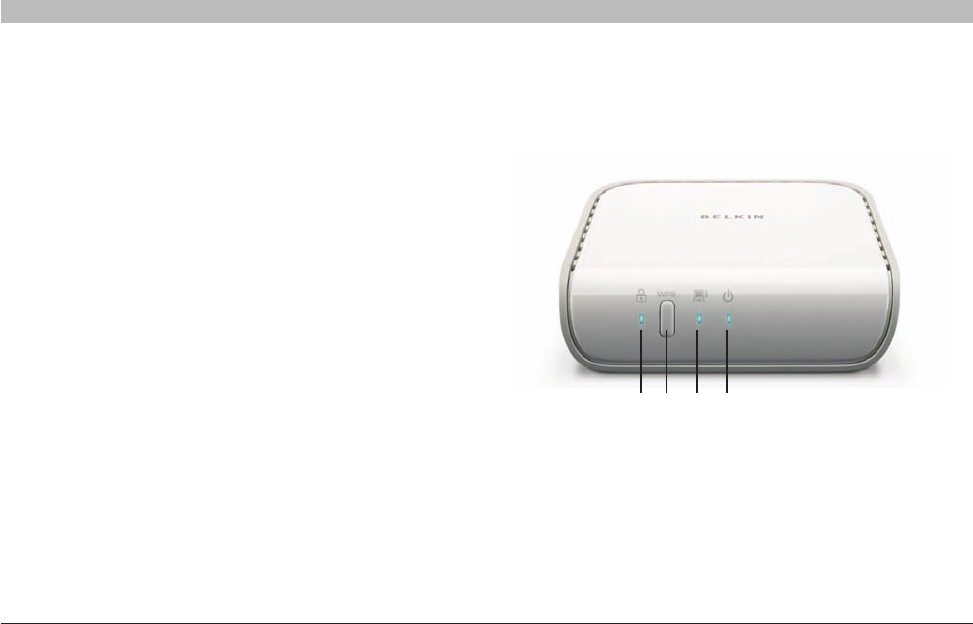
(A) Wireless Security – Indicates wireless security is enabled when lit
(B) WPS Connect Button – Automatically establishes secure wireless
connection to routers with similar WPS connect button feature
(C) Wireless Connection – Indicates wireless LAN connection when lit
(D) Power – On/Off
1
Home Base
SECTIONSTable of Contents 23456789 1510 11 12 13 141
INTRODUCTION
Thank you for purchasing the Belkin Home Base. By following these simple setup instructions, your Belkin Home Base will allow you
to share your USB printer and hard drives, with any computer or laptop on your home network. The Control Center software offers a
convenient central location to configure the Home Base and the USB devices you attach to it.
Home Base Capabilities
• Share and control printers and scanners among all
the networked computers in your home
• Share external drives with all the networked computers
in your home
• Back up critical and precious content from all your networked
computers to an external drive for safekeeping
• Schedule automatic backups to regularly archive new content
and changes
• Automatically share pictures on Flickr® and Picasa®
• Set up an external drive to act as a DLNA server for
your media content
• Media files served through Home Base’s drive can be
accessed directly from Xbox 360™, PlayStation® 3, and
other DLNA client devices
(A) (B) (C) (D)

2
Home Base
SECTIONSTable of Contents 23456789 1510 11 12 13 141
INTRODUCTION
Benefits of Home Base
• Share – Easily pass files back and forth across the network. Share
music, photos, video, documents, or any content you want by
placing it on the external drive attached to Home Base.
• PeaceofMind – All your critical content can be backed up to the
drive(s) attached to Home Base. All your family photos and critical
documents will be safe from computer crashes.
• Mobility – Print and scan from anywhere in the home. You are no
longer tethered to the computer, nor do you need to email print
jobs to a computer physically connected to the printer.
• Freedom – Hide your printers, scanners, and external drives
out of sight.
• Flexibility – Any USB peripheral can be shared among all your
networked computers simply by attaching it to Home Base.
Package Contents
• Belkin Home Base
• Quick Installation Guide
• Belkin Setup Assistant Software CD
• RJ45 Ethernet Networking Cable
• Power Supply
• User Manual on the Setup Assistant CD
System Requirements
• Windows® 2000, XP, or Vista® 32- or 64-bit
• Mac OS® X v10.4 or v10.5
• Minimum 1GHz processor and 128MB RAM
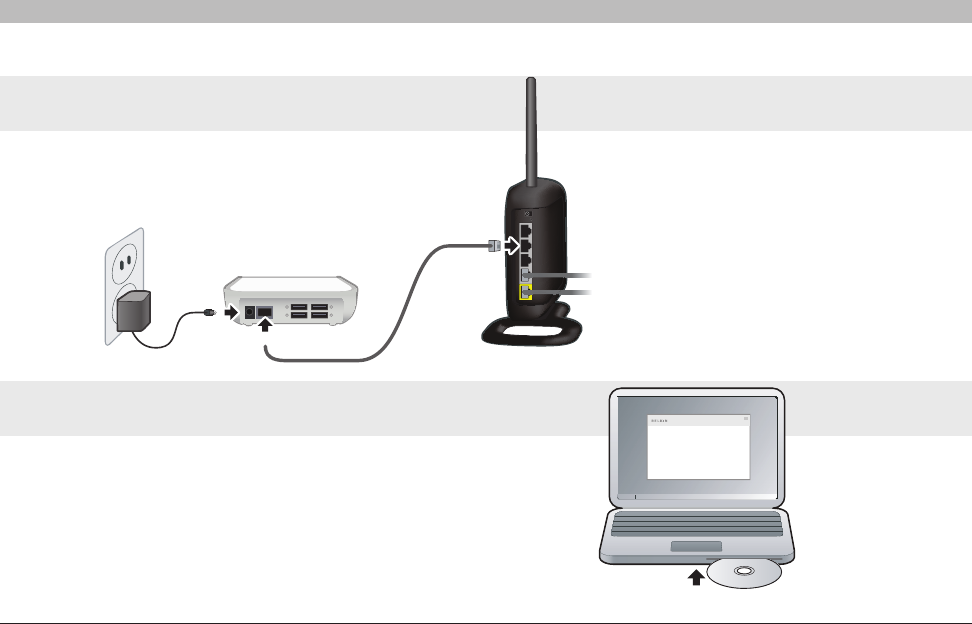
3
Home Base
SECTION STab le o f Co nt en t s 1 3 4 5 6 7 8 9 1510 11 12 13 14
GETTING STARTED
2
Connect Home Base to your network
1
First, connect Home Base to your router with a network
cable. Next, plug the included power supply into Home
Base and into a power outlet.
If you’d like to use Home Base wirelessly,
plug it into your router for now. The setup
software will help you make Home Base
operate on your wireless network. You can
also use WPS to wirelessly set up Home Base.
See the help file on the CD for details.
Run the setup software
2
Run the setup software to make Home Base a member of your network.
Insert the CD, and the setup software will run*. Choose “Set Up Home
Base”. If you don’t already have it installed, the setup software will also
install Control Center on your machine.

4
Home Base
SECTION STab le o f Co nt en t s 1 3 4 5 6 7 8 9 1510 11 12 13 142
GETTING STARTED
Install Control Center on other computers
3
You will need to install Control Center on each additional
computer that will use Home Base. Insert the CD and the
setup software will run*. Choose “Install Control Center”.
*If the setup software does
not run automatically, browse
the CD and run “Setup”.
Connect USB devices
4
Once Home Base is a member of your network, you’re
ready to plug in printers, hard drives, and other USB
devices to share among your computers. Simply plug each
device into an open USB port on the back of Home Base.
Note: If you plug a printer into Home Base, each
computer will ask you to install the printer’s driver if it
hasn’t been done already. You’ll only have to do this once.
You can manage these devices via the Control
Center, the icon of which appears in your system
tray (Windows®) or menu bar (Mac OS® X). It is
also accessible via the Start menu (Windows) or
Applications folder (Mac OS X).

5
Home Base
SECTIONSTable of Contents 12 456789 1510 11 12 13 14
WIRELESS SETUP
3
There are three ways to attach your Home Base to your
wireless network:
• WiredSetupofWirelessMode
• WPSPushButtonConfiguration
• WPSPINConfiguration
Wired Setup of Wireless Mode
Note: If Home Base is powered on while plugged into a router, it
will operate as a wired device. To enable Wireless mode, follow
instructions below.
The setup software will help you make Home Base operate as a member
of your wireless network.
1. Start by connecting your Home Base to your router.
(You’ll unplug it later.)
2. Connect the AC adapter.
3. Run the setup software and follow the software’s instructions
to set up the Home Base.
4. When offered wireless setup, select a wireless network.
5. The setup software will tell Home Base what network you chose.
Follow the software’s instructions to unplug your Home Base from
the router and turn it off and on.
6. Your Home Base will then operate as a member of your
wireless network.
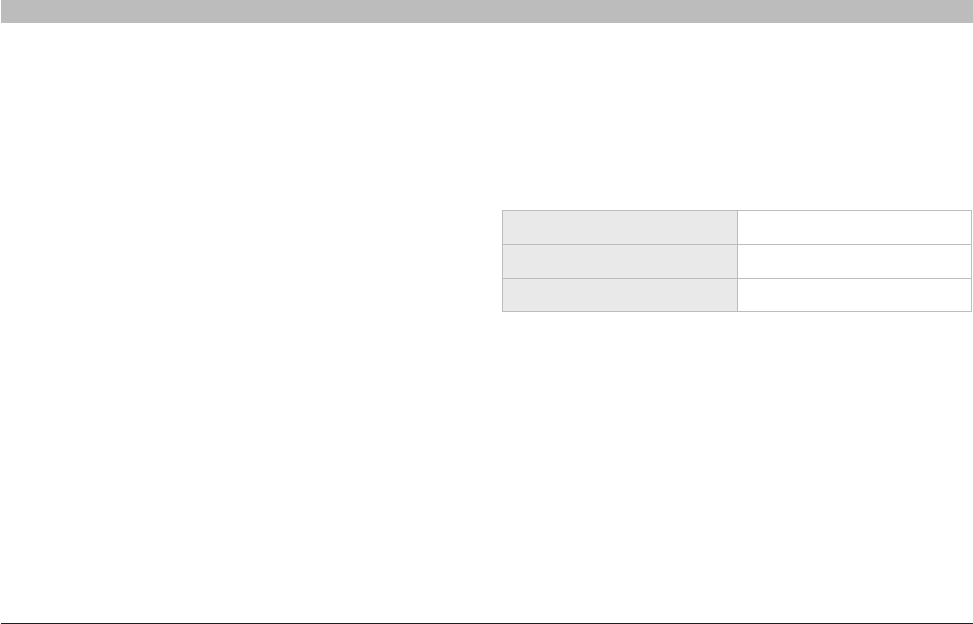
6
Home Base
SECTIONSTable of Contents 12 456789 1510 11 12 13 143
WIRELESS SETUP
WPS Push Button Configuration
If your router supports WPS, the WPS Push Button Configuration (PBC) is the quickest way to get Home Base onto your
wireless network.
Status of WPS Wireless Security:
Off Wireless security is off
Blinking Blue WPS handshaking in process
Solid Blue Wireless security is on
If a connection is established, Home Base’s security LED will come on
in solid blue.
If a connection is not established after more than two minutes, the
security LED will flash quickly and continuously for 10 seconds, then
stop, and you’ll need to try again.
If Home Base couldn’t determine to which router to connect, the
security LED will flash in bursts of five for 10 seconds, then stop, and
you’ll need to try again.
1. Make sure Home Base is NOT plugged into your router.
2. Connect the AC adapter.
3. Push the WPS button on your router. (Refer to your router’s
instruction manual.)
4. Push and hold the WPS button on Home Base. Release the WPS
button when the blue security LED on the Home Base and the LED
start blinking. Once the LED starts blinking in longer intervals for
approximately three seconds, release the button.
5. Home Base and your router will negotiate a connection.

7
Home Base
SECTIONSTable of Contents 12 456789 1510 11 12 13 143
WIRELESS SETUP
1. Read the PIN code from the bottom of Home Base.
2. Make sure Home Base is NOT plugged into your router.
3. Connect the AC adapter.
4. Push and hold the WPS button on Home Base. Release the WPS
button when the security LED on Home Base starts blinking short
blinks after about 10 seconds.
5. Enter the PIN code into your router’s interface. (Refer to your
router’s instruction manual.)
6. Home Base and your router will negotiate a connection.
If a connection is established, Home Base’s security LED will come on
in solid blue.
If a connection is not established after more than two minutes, the
security LED will flash quickly and continuously for 10 seconds, then
stop, and you’ll need to try again.
For more information on wireless setup, see the “Troubleshooting” and
“FAQs” sections in this manual.
WPS PIN Configuration
If your router does not support the WPS Push Button Configuration, the alternative is to apply the WPS security using the PIN
Configuration. Locate the 8-digit PIN code on the bottom of Home Base and enter this pin into your router to manually initiate a
WPS connection.
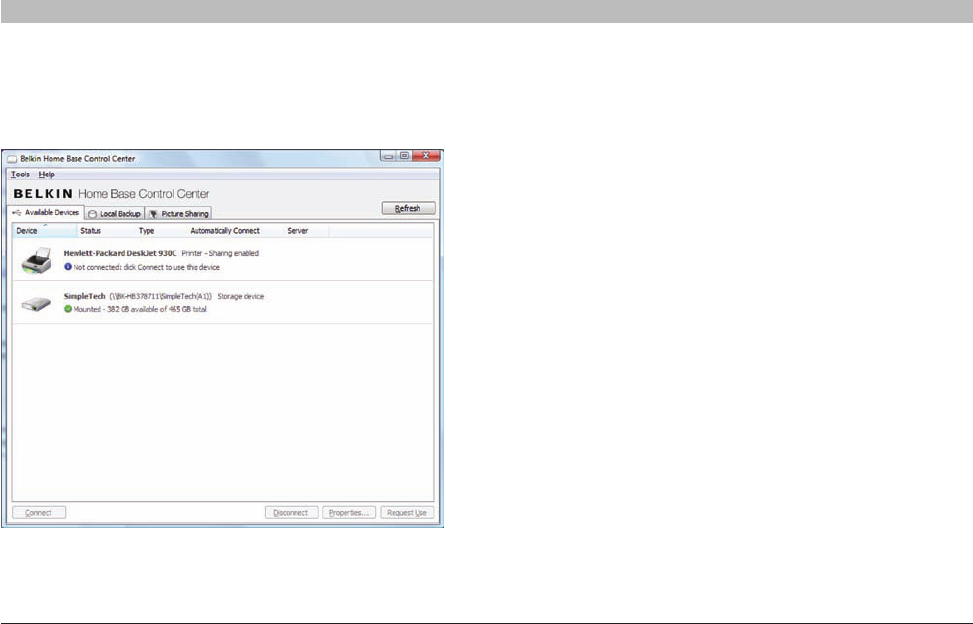
8
Home Base
SECTIONSTable of Contents 123 56789 1510 11 12 13 14
AVAILABLE DEVICES LIST
4
The “Available Devices” tab displays a list of USB devices connected
to Home Base and allows you to select devices and specify connection
settings for them. For more information, see the “Device Properties”
section on the next page.
To connect to a USB device, select it and click “Connect”. Alternatively,
you can double-click on a device to connect to it. If you double-click
on a disk drive, you can access the contents of the disk drive.
By default, disks attached to Home Base are shared with all computers
on the network. A disk can be unmounted safely by selecting it and
clicking “Disconnect”. A disk that is not mounted can be mounted again
by unplugging and plugging its USB cable back into Home Base.
If someone is using a device you’d like to use, select the device and
click “Request Use”. A message will appear on the user’s computer
notifying him or her that you wish to use this device. They can elect to
make the device available to you, or not.
The “Available Devices” tab displays a list of USB devices connected to Home Base and allows you to select devices and specify
connection settings for them. For more information, see the “Device Properties” section below.
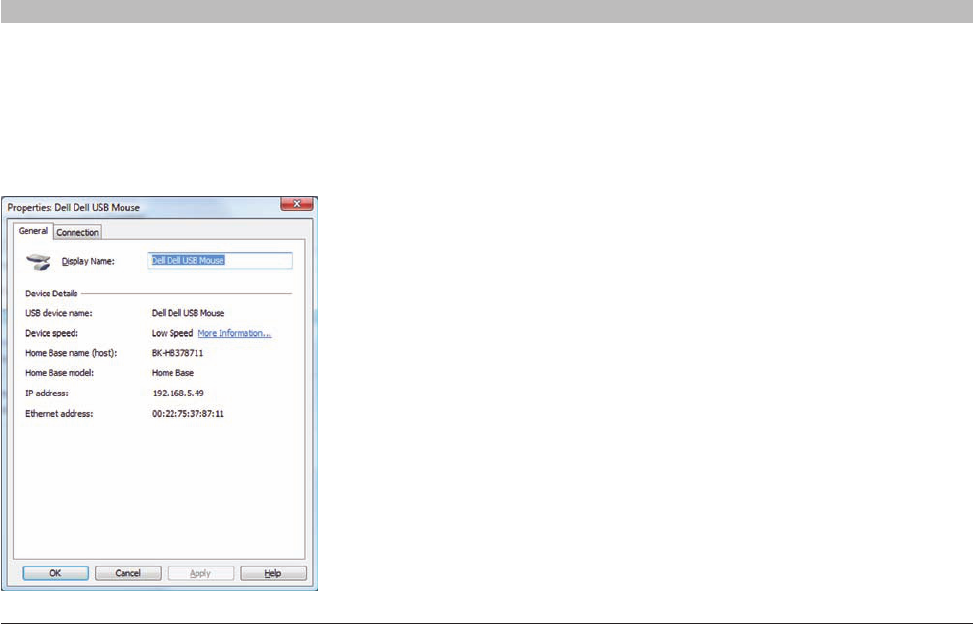
9
Home Base
SECTIONSTable of Contents 1234 6789 1510 11 12 13 14
DEVICE PROPERTIES
5
To access the properties sheet for an individual device, select the device in Control Center and click “Properties”. The properties
sheet allows you to specify general settings such as the name that the device will appear as in the Control Center, whether the
device should automatically connect with a computer via the Home Base as soon as the computer starts, and more.
General Properties The “General” tab of the “Device Properties” screen enables you to
change the name the device appears as in the Control Center and
displays various reference information about the device.
In the “Display Name” field, enter the name of the device as you want
it to appear in the Control Center. The default name is gathered by the
Control Center from the device itself. This default name will always
appear as the USB device name, even if you change the “Display
Name”.
“Device speed” is shown as reported by the particular device. Actual
performance is also affected by other factors such as your network
configuration.
1. Hi-Speed: USB products that carry the “Hi-Speed USB” logo and
support a speed of 480Mbps.
2. Full Speed: USB products that carry the basic “Certified USB” logo
and support a speed of up to 12Mbps.
3. Low Speed: Supports up to 1.5Mbps.
The “General” tab also contains reference information about the device.

10
Home Base
SECTIONSTable of Contents 1234 6789 1510 11 12 13 145
DEVICE PROPERTIES
Device Connection Properties The “Connection” tab of the “Device Properties” screen enables you
to specify if the device should connect automatically to this computer
when the computer is started, and if any software should start
automatically when the device connects. The information in this topic
applies to all devices except printers and disks that are shared via NAS
mode. To learn about connection properties for printers, see the “Printer
Connection Properties” section.
Check the “Automatically connect this device when the Home Base
Control Center starts” check box if you want to this computer to
automatically connect to this device each time Control Center starts. If
you mark this check box along with the box that specifies if the Control
Center should start, the device will automatically connect each time you
start the computer.
Connections to devices may occasionally be lost due to network
failures or other factors. If you want the Control Center to automatically
reconnect with the device should this occur, check “Attempt to
reconnect the device if the connection is lost”. The Control Center will
try to reconnect with the device until the connection is reestablished or
the computer is shut down.
Use the “Launch Program” field to specify settings for any software
associated with this device. For example, a webcam probably has
software that captures video. By checking “Launch a program when this
device connects”, you can specify that the software starts automatically
when the webcam is available. You can also check “Disconnect device
when the program is closed” if you want to free up the device for use by
other computers when you close the software.
In the “Program” field, browse to find the software you want to associate
with the device. You can also enter the path to the program directly into
the field. Once your settings are saved, only the name of the program
appears in the “Program” field.
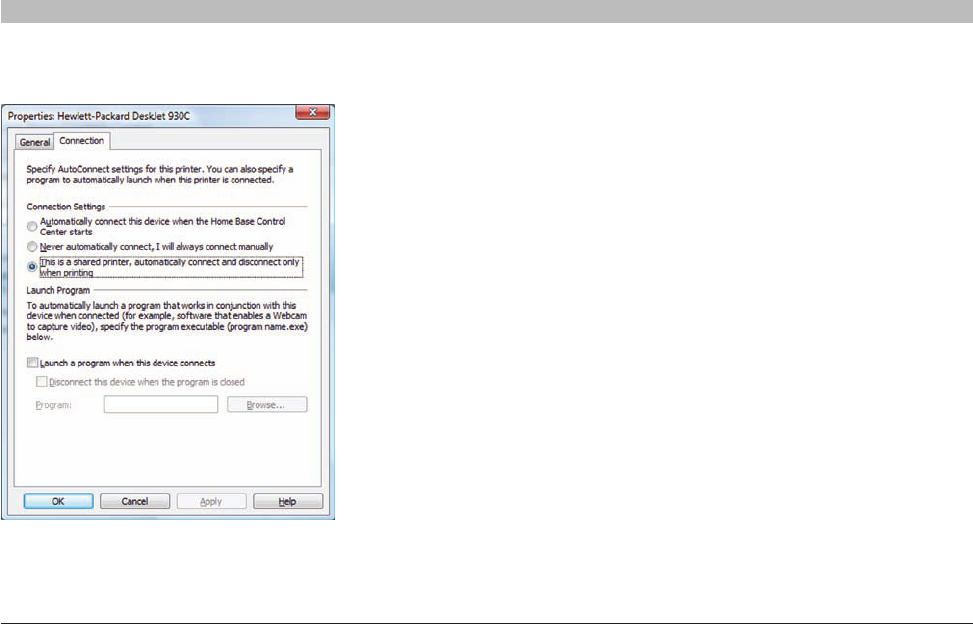
11
Home Base
SECTIONSTable of Contents 1234 6789 1510 11 12 13 145
DEVICE PROPERTIES
Printer Connection Properties
When a printer is selected, the “Connection” tab of the “Device
Properties” screen offers additional functionality specific to printers.
In particular, you can select one of three options for automatically
connecting the device.
If the printer is being shared among multiple computers, we recommend
selecting “This is a shared printer, automatically connect and disconnect
only when printing”. With this option, the printer is automatically
connected when a print job is sent to it, then is disconnected as soon as
the job completes so the printer is then available for other computers.
Check “Automatically connect this device when the Home Base Control
Center starts” if you want this computer to automatically connect to
this printer each time the computer starts, preventing other users from
connecting to the printer automatically.
You can force users to manually connect to the printer with the “Never
automatically connect, I will always connect manually” option.
The “Printer” field is enabled if you select one of the automatic
connection options. From the drop-down list, select the printer driver
associated with this printer.
Connections to devices may occasionally be lost due to network
failures or other factors. If you want the Control Center to automatically
reconnect with the device should this occur, check “Attempt to
reconnect the device if a connection is lost”. The Control Center will try
to reconnect with the device until the connection is reestablished or the
computer is shut down.
Use the “Program” field to specify settings for any software associated
with this printer. You can also check “Disconnect this device when the
program is closed” if you want to free up the device for use by other
computers when you close the software.
In the “Program” field, browse to find the software you want to associate
with the printer. You can also enter the path to the software directly into
the field. Once your settings are saved, only the name of the program
appears in the “Program” field.
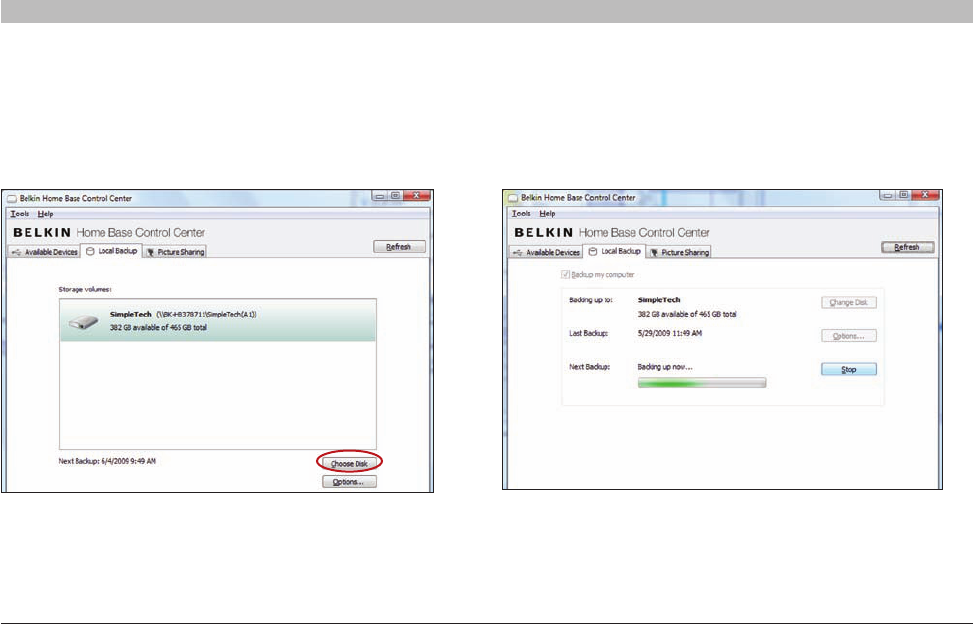
12
Home Base
SECTIONSTable of Contents 12345 789 1510 11 12 13 14
LOCAL BACKUP
6
To set up a backup from your computer, select the volume to which you
want to back up and click “Choose Disk”.
The backup job screen will appear. The name of the disk, and its free
space, will be shown, as well as the date and time of the next backup.
Your backup will begin when indicated by “Next Backup”, or you can
start backing up immediately by clicking “Backup Now”. The status of
your backup will be shown via a progress bar. The first backup can take
a while as it copies all of the files on your computer. Once the initial
backup is complete, the Control Center will monitor your computer and
only back up new and changed files.
The Belkin Home Base Control Center Local Backup tab enables you to easily back up the files from your computer to USB drives
connected to Home Base.
If you want to change the disk volume used for backup, click
“Change Disk”.
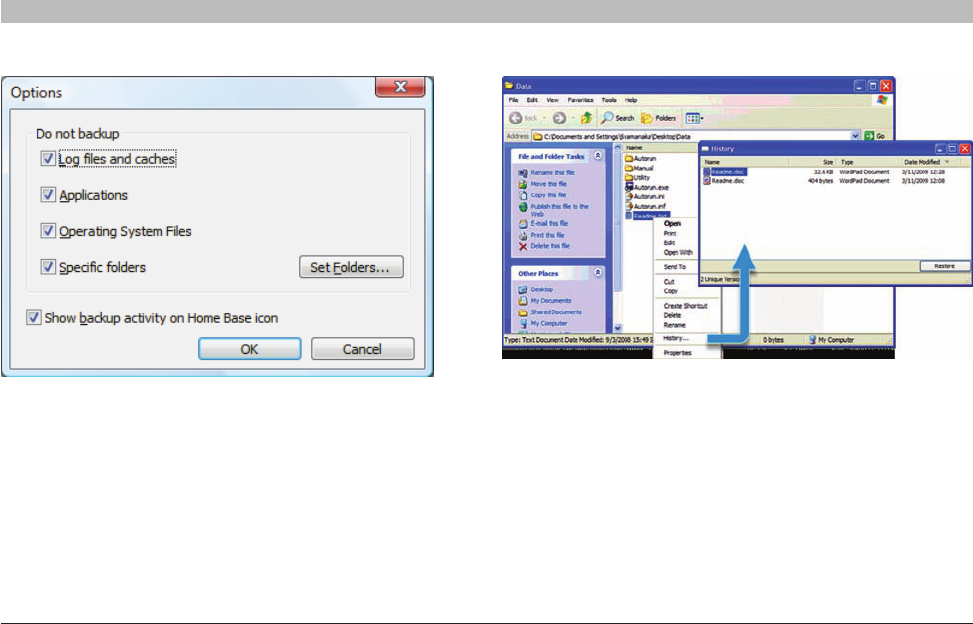
13
Home Base
SECTIONSTable of Contents 12345 789 1510 11 12 13 146
LOCAL BACKUP
Click “Options” to exclude files from the backup. This can help your
backup happen faster. You can choose to exclude “Log files and
caches”, “Operating system files”, and “Applications”, and elect to
exclude one or more “Specific folders”. To exclude specific folders, click
“Set Folders” and choose which ones you don’t need to back up.
To restore files back to your computer, you can right-click on a file or
folder you wish to restore and choose “History” to bring up the history
browser, which will list all versions of the file/folder existing in the backup.
Select an item from the list and click the “Restore” button, which will allow
you to choose a restore destination. You may also drag an item from the
history browser to a location of your choice. You can also browse to the
“Local Backup” folder on the backup disk to find a version of the file.

14
Home Base
SECTIONSTable of Contents 12345 789 1510 11 12 13 146
LOCAL BACKUP
If you want to perform a full restore of your computer, launch the
“Restore Utility” found in the “Local Backup” folder of the drive that
received the backup.
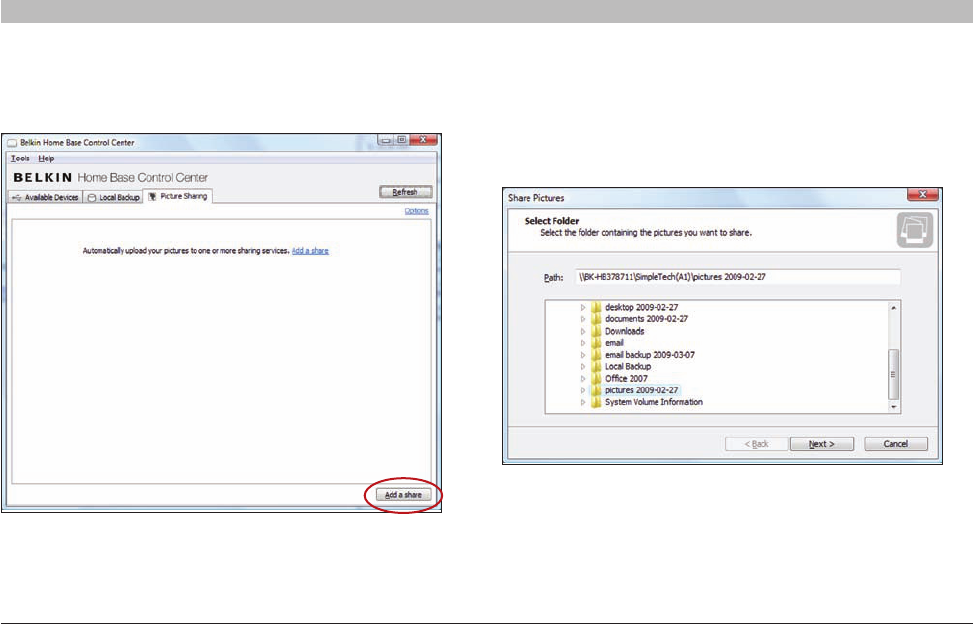
15
Home Base
SECTIONSTable of Contents 123456 89 1510 11 12 13 14
PICTURE SHARING
7
The “Picture Sharing” tab enables you to automatically upload pictures from USB disks connected to the Home Base to
picture-sharing sites like Flickr and Picasa.
To enable this feature, click “Add a share” and select a folder from the
disk(s) connected to the Home Base. Home Base will monitor this folder
for pictures.
If you want to change the time that Home Base performs the picture
uploads to the online services, click “Options”.
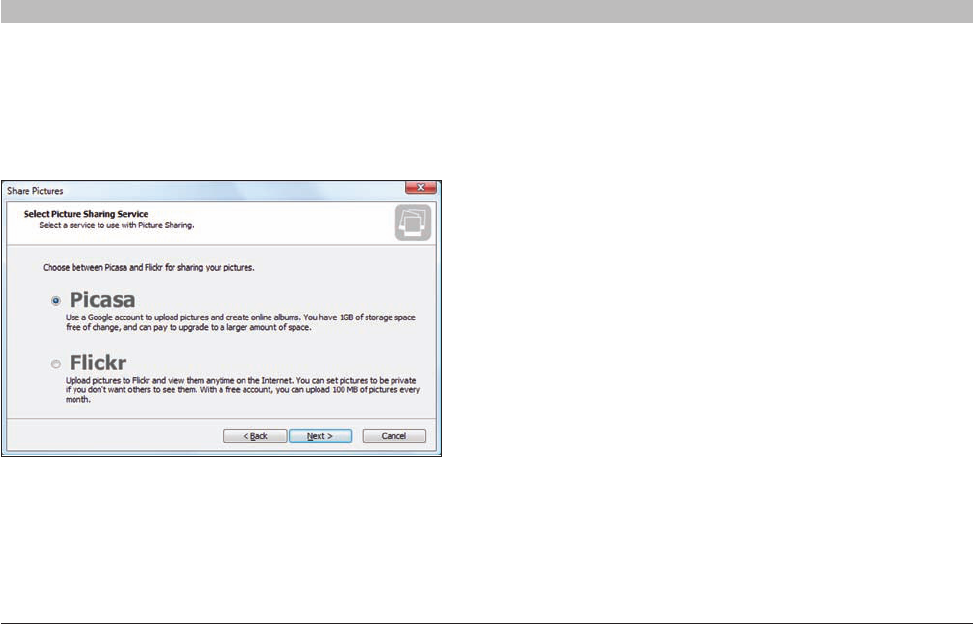
16
Home Base
SECTIONSTable of Contents 123456 89 1510 11 12 13 147
PICTURE SHARING
Now select the photo-sharing site you want to use and follow the
prompts. If you don’t have a Flickr or Picasa account, you will need to
sign up for one, which you can do for free.
The “Picture Sharing” configuration wizard will ask you for your online
photo-sharing account information; you will need to authorize your
Home Base product so it can access your account and automatically
upload your pictures. The wizard will also ask you how often you want to
check for pictures to upload them.
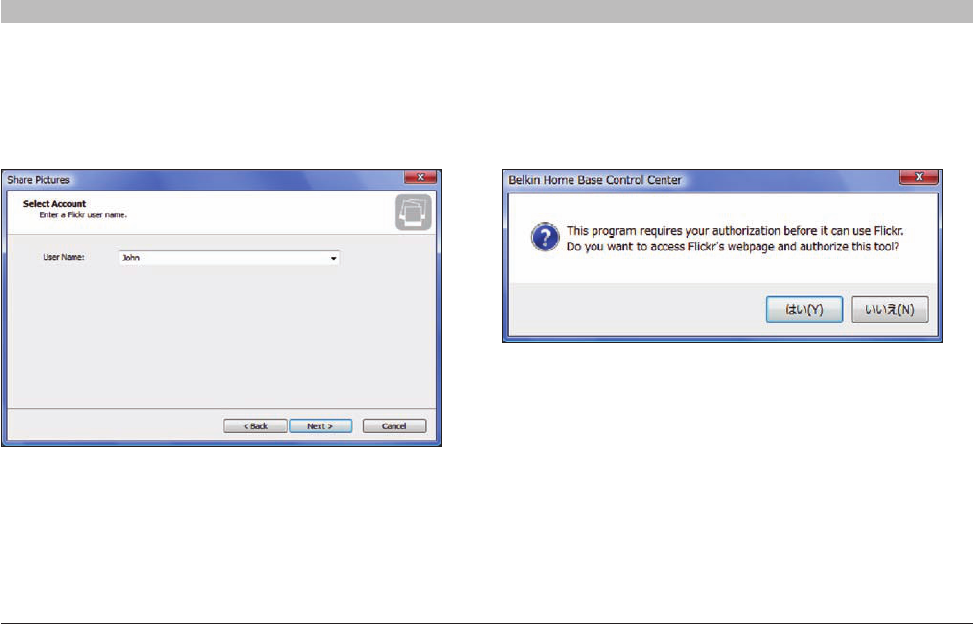
17
Home Base
SECTIONSTable of Contents 123456 89 1510 11 12 13 147
PICTURE SHARING
Flickr Account Selection
A Flickr account is selected here. Next to “User Name”, the user names
stored in Home Base are displayed in a combo box.
If a new user name is entered, Flickr tool authorization is necessary. In
this case, clicking “Next” will bring up the following message.

18
Home Base
SECTIONSTable of Contents 123456 89 1510 11 12 13 147
PICTURE SHARING
If “OK” is clicked, the default web browser will launch and the Flickr
authorization page will be displayed. Control Center will display a
message telling the user to dismiss it when authorization is complete.
After authorization is complete, the user clicks the message box’s “OK”
button. The new user account information is stored to Home Base and
the wizard continues.
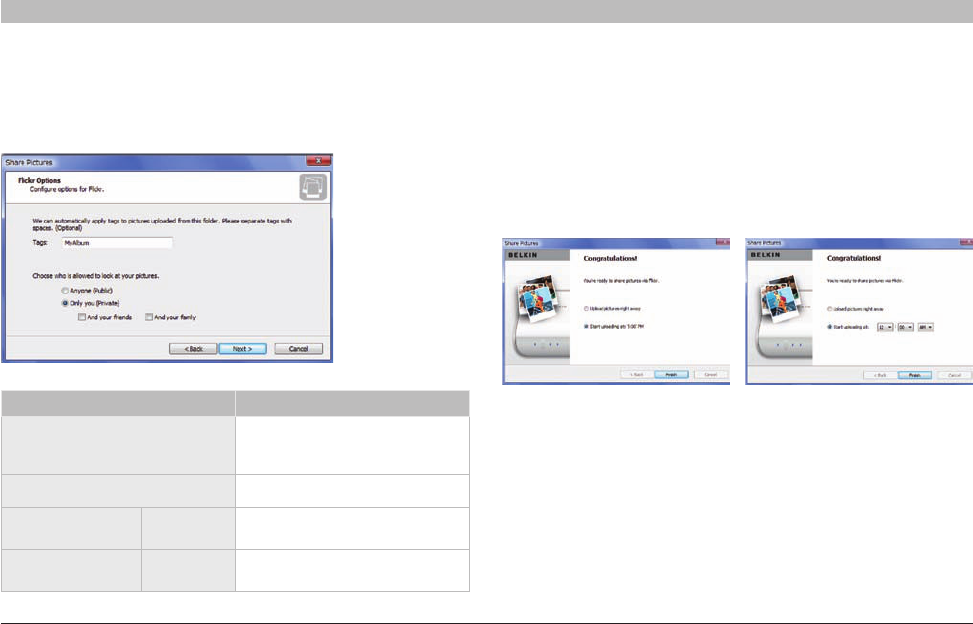
19
Home Base
SECTIONSTable of Contents 123456 89 1510 11 12 13 147
PICTURE SHARING
Flickr Optional Settings
Optional settings are configured here.
Begin Upload
After adding a picture job, the user will choose whether to perform the
upload immediately, or wait until the configured time. When “Finish” is
clicked, the upload will be performed according to the user’s selection.
If an upload time was not already configured for Home Base, it can be
configured before clicking “Finish” (see bottom right image). If a time is
configured for one folder, it will be used for all other folders as well.
Item Description
Tags
Sets tag information. Up to 64
tags can be entered, with each
tag separated by a space.
Anyone (Public) All users can view the pictures.
Only You (Private) Friends can also view the
pictures.
Family members can also view
the pictures.
And Your
Friends
And Your
Family
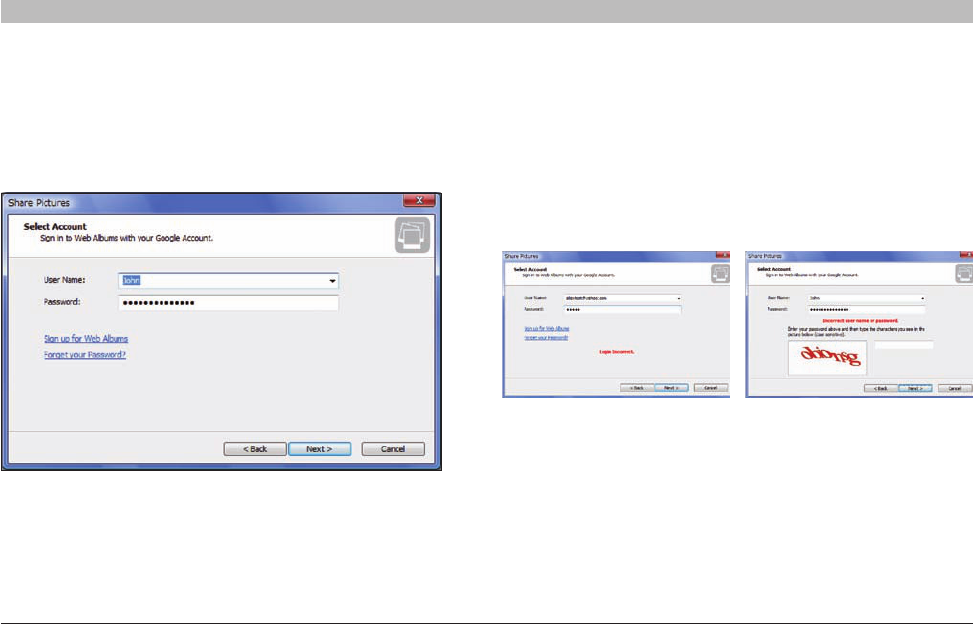
20
Home Base
SECTIONSTable of Contents 123456 89 1510 11 12 13 147
PICTURE SHARING
Picasa Account Selection
A Picasa account is selected here. Next to “User Name”, the user names
stored in Home Base are displayed in a combo box. If a new user name
is entered, Home Base will automatically store the account information.
If “Sign up for Web Albums” is clicked, the sign-up page for Picasa
Web Albums will open in a web browser. The user can create a Google
Account there if he or she does not already have one.
A login error will be displayed if user authentication failed. If the
user forgot his or her password, he or she can click the “Forget your
Password?” link to open the Google Account password confirmation
page in a web browser.
If user authentication fails several times, the user may have to enter a
CAPTCHA (see bottom right image).
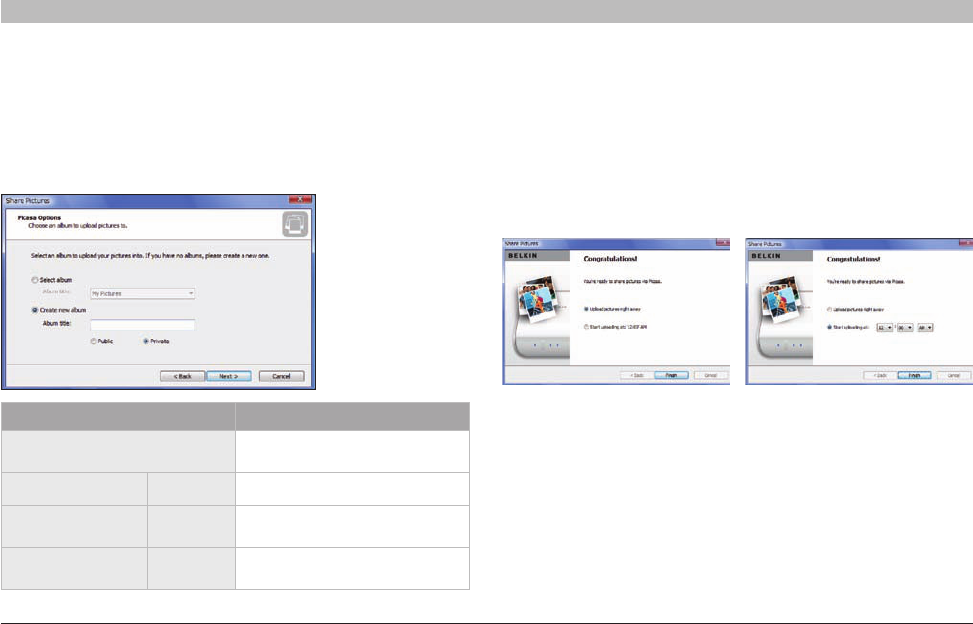
21
Home Base
SECTIONSTable of Contents 123456 89 1510 11 12 13 147
PICTURE SHARING
Album Configuration
The album to upload pictures is selected here. An existing album can
be selected, or a new album can be created. If there are no albums for
the Picasa account, a new album must be created, and “Select album”
cannot be chosen.
Begin Upload
After adding a picture folder, the user will choose whether to perform the
upload immediately, or wait until the configured time. When “Finish” is
clicked, the upload will be performed according to the user’s selection.
If an upload time was not already configured for Home Base, it can be
configured before clicking “Finish” (see bottom right image). If a time is
configured for one folder, it will be used for all other folders as well.
Item Description
Select Album Choose album to upload
pictures to.
Create new Album Title of the new album.
Allow all users to view the
pictures in this album.
Allow only users with authority
to view the pictures.
Album Title
Public
Private
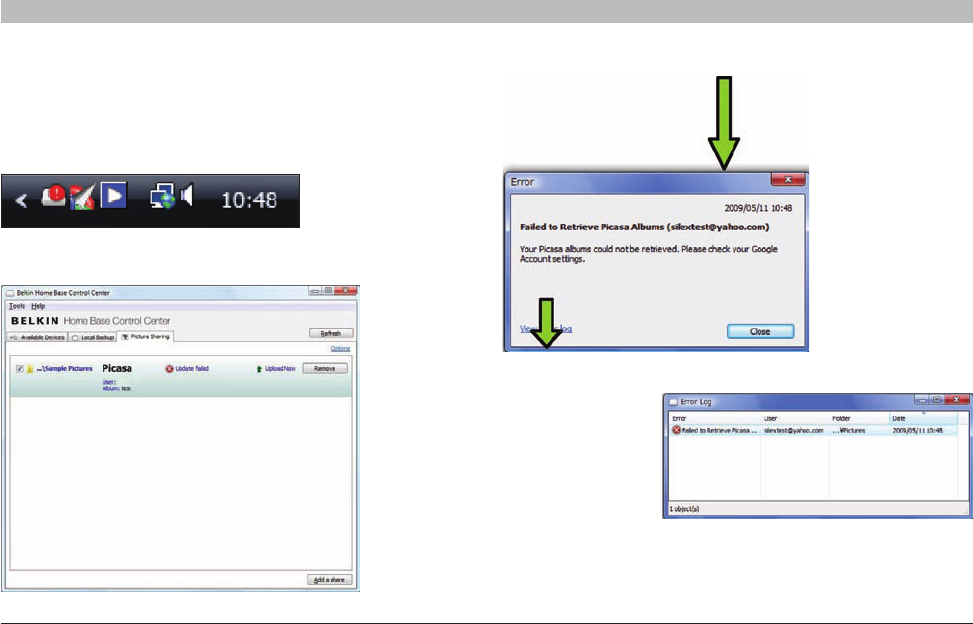
22
Home Base
SECTIONSTable of Contents 123456 89 1510 11 12 13 147
PICTURE SHARING
Error Notification
If an error occurs while Picture Sharing is in progress, the user will be
notified via an icon (or balloon help) in the task tray on Windows, or an
icon on the system status bar on Mac OS X.
When the icon is clicked, the Picture Sharing screen in Control Center
will open.
In the folder list, an
error status message
will be displayed for
items where an error
occurred. When the
message is clicked,
the Error Information
Dialog will pop up.
The Error Information
Dialog displays
detailed information
about the error. Also,
the user can configure
whether he or she
wants newer pictures
uploaded first, or older
pictures uploaded first.
If “View Error Log” is
clicked, a log of errors
for the selected folder
will be displayed.

23
Home Base
SECTIONSTable of Contents 123456 89 1510 11 12 13 147
PICTURE SHARING
Once you have configured Home Base to upload pictures to a photo-sharing
site, a list of folders and their associated sites will be shown on the “Picture
Sharing” tab. Each list item will show its status and the time of last upload. If
you want to share additional folders, click “Add a share”.
If you want to change the time that Home Base performs the picture uploads
to the online services, click “Options”.
To disable a share, uncheck its check box. To delete a sharing job
permanently, click “Remove”.
To access your pictures, log in to your account at www.flickr.com or
www.picasa.com to view your pictures online.
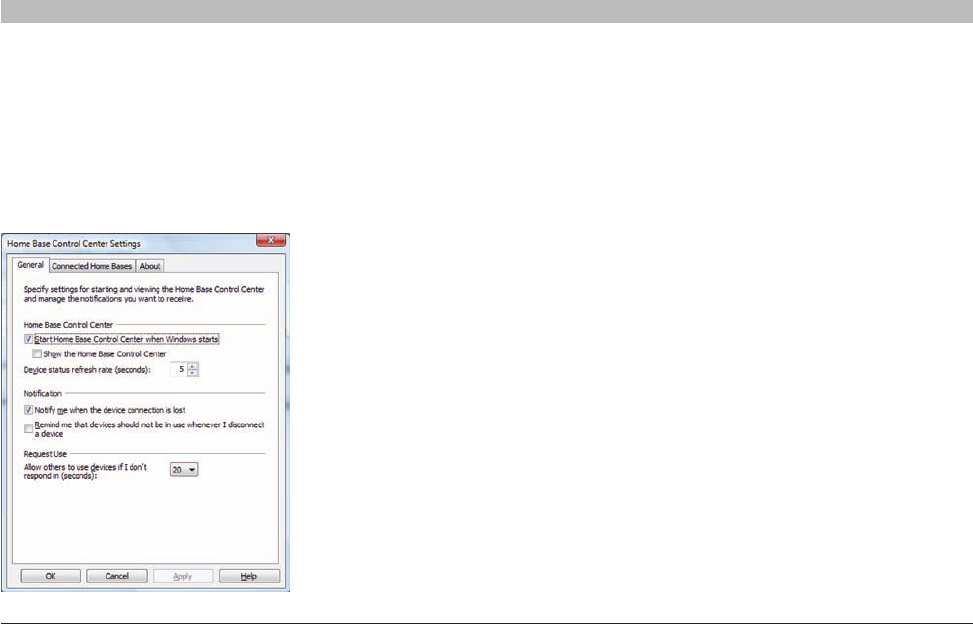
24
Home Base
SECTIONSTable of Contents 1234567 9 1510 11 12 13 14
CONTROL CENTER OPTIONS
8
You can specify general settings such as whether you want the Control Center software to start when you start your computer, how
you want to update Control Center software, and more.
To access “Control Center Settings” properties, click “Tools > General” or “Tools > Connected Home Bases” in Control Center.
General Settings
On the “General” tab, you can specify when you want Control Center
to start and the types of notifications you want to see.
If you check “Start Home Base Control Center when Windows Starts”,
any devices to which you choose to automatically connect will be ready
for use when you start your computer. For more information, see the
“Device Properties” section.
The “Show the Home Base Control Center” check box makes Control
Center appear each time you start the computer.
Under “Notification” you can specify which notifications you want to
see. Mark check boxes to:
1. Notify me when the device connection is lost – to inform you when
the connection to a USB device is lost. This is enabled by default.
2. Remind me that devices should not be in use whenever I
disconnect a device – to remind you that you should ensure
a device is not in use before disconnecting. For example,
disconnecting a storage device while files are open could result in
data loss. This is disabled by default.
You may also specify how often you want the device list to be refreshed.
This rate determines how often Control Center updates the status of
attached devices.
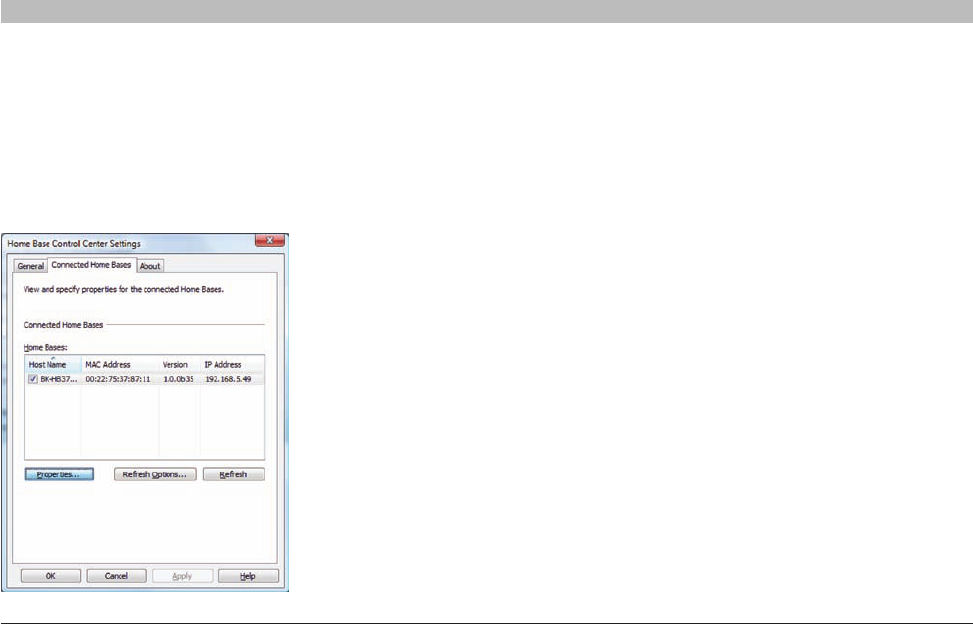
25
Home Base
SECTIONSTable of Contents 1234567 9 1510 11 12 13 148
CONTROL CENTER OPTIONS
Connected Home Bases
On the “Connected Home Bases” tab you can view all Home Bases
available on your network and set properties for them.
All connected Home Bases are listed in the box. Select one and click
“Properties” to view its settings. This will open the web browser
configuration of Home Base. It consists of status, configuration,
maintenance, and help pages.
Network administrators who are administering a network containing
subnetworks can click “Refresh options” to specify broadcast IP
addresses to be used when the Control Center searches the network for
Home Base.
For more information on Home Base web browser interface, you can
click on “Help” on any of the web pages.
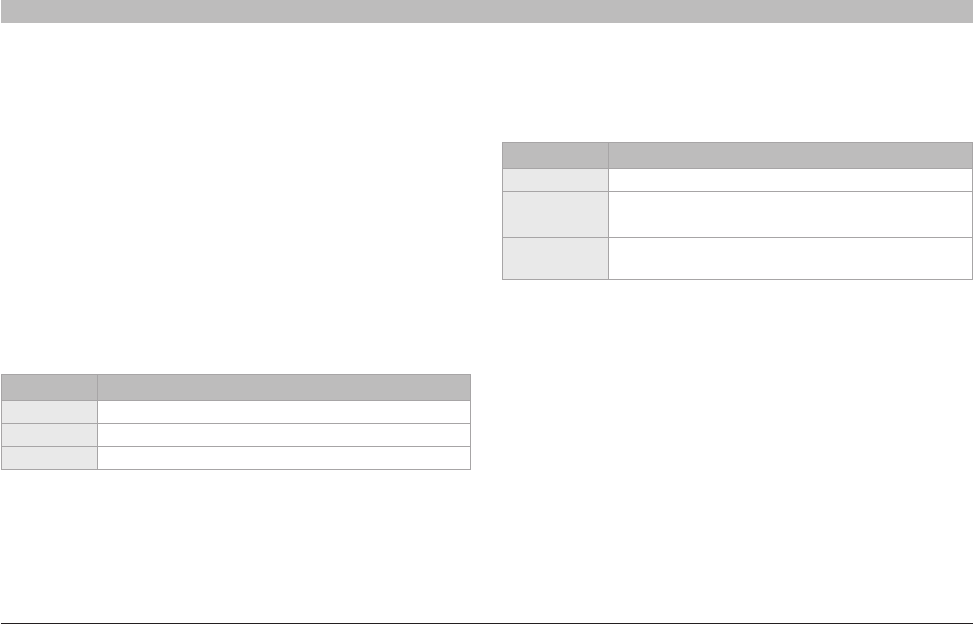
26
Home Base
SECTIONSTable of Contents 12345678 1510 11 12 13 14
MEDIA SERVER
9
Overview
Home Base can distribute pictures, movies, and music (called media
files) to UPnP media players by using UPnP.
Function Features
This Media Server distributes media files in USB storage to media
players. It makes virtual directories, “Image,” “Music,” and “Movie.”
These virtual directories consist of sub-directories and each kind of
media file.
Supported Media Formats
This Media Server supports the following file types:
Media Type Format(FileExtension)
Image JPEG (.jpg) PNG (.png)
Movie MPEG-1 (.mpg) MPEG-2 (.mpg .mpeg) MPEG-4 (.m4v .m4p .mp4)
Music AC3 (.ac3) LPCM (.wav) MP3 (.mp3) MPEG-4 (.m4a) WMA (.wma)
In addition, the following files may be showed on file lists that the media
player displays:
Table 1 File Formats
Media Type FileExtension
Image .bmp .ico .gih .jpe .pnm .ppm .qti .qtf .qtif .tif .tiff
Movie asf .avc .avi .dv .divx .wmv .mjpg .mjpeg .mpe .mp2p .vob .mp2t .m1v .m2v
.mpg2 .mpeg2 .mp4ps .ts .ogm .mkv .rmvb .mov .hdmov .qt .bin .iso .asx
Music 3gp .aac .aif .aiff .at3p .au .snd .dts .rmi .mid .mp1 .mp2 .ogg .pcm
.lpcm .l16 .wma .mka .ra .rm .ram .flac .pls .m3u
Supported Media Players
• Sony® PlayStation®
• Microsoft®Xbox360™
About
The “About” tab shows which version of Control Center you are running
and software support contact information. Should you need to send an
email support request, please include the software version number in
your description.
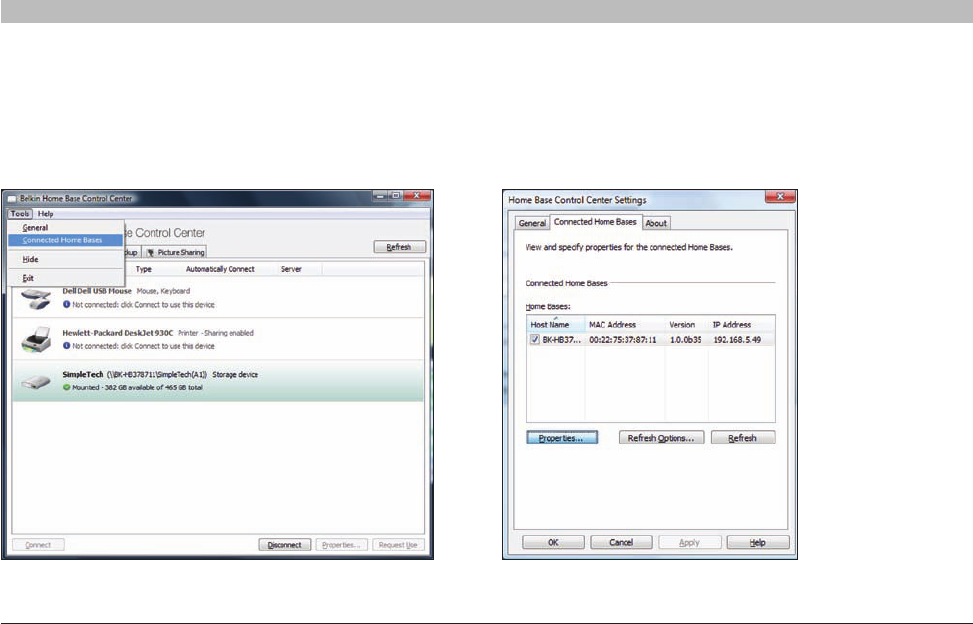
27
Home Base
SECTIONSTable of Contents 123456789 11 12 13 1410
UPGRADING HOME BASE FIRMWARE
13
Firmware Update Instructions
From the Home Base Control Center software, click on “Tools”,
then “Connected Home Bases”. Choose your Home Base from the list (check the MAC address on the
label of the bottom of Home Base with the MAC address in the list) and
select “Properties”.
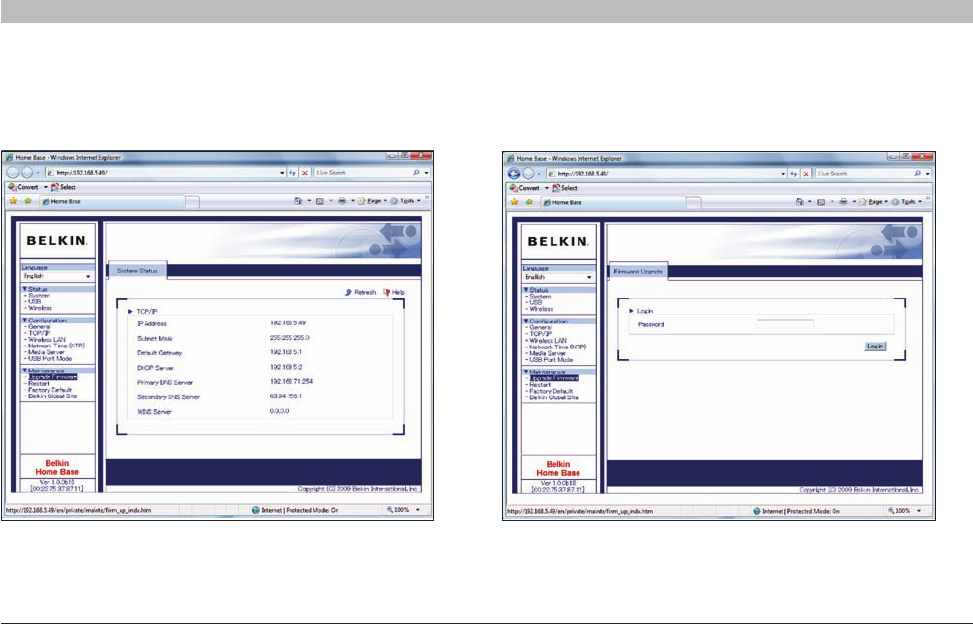
28
Home Base
SECTIONSTable of Contents 123456789 11 12 13 1410 13
UPGRADING HOME BASE FIRMWARE
Your web browser should open to the Home Base configuration page.
Click on “Upgrade Firmware”.
Type in your Home Base password (there is no password by default),
and click “Login”.
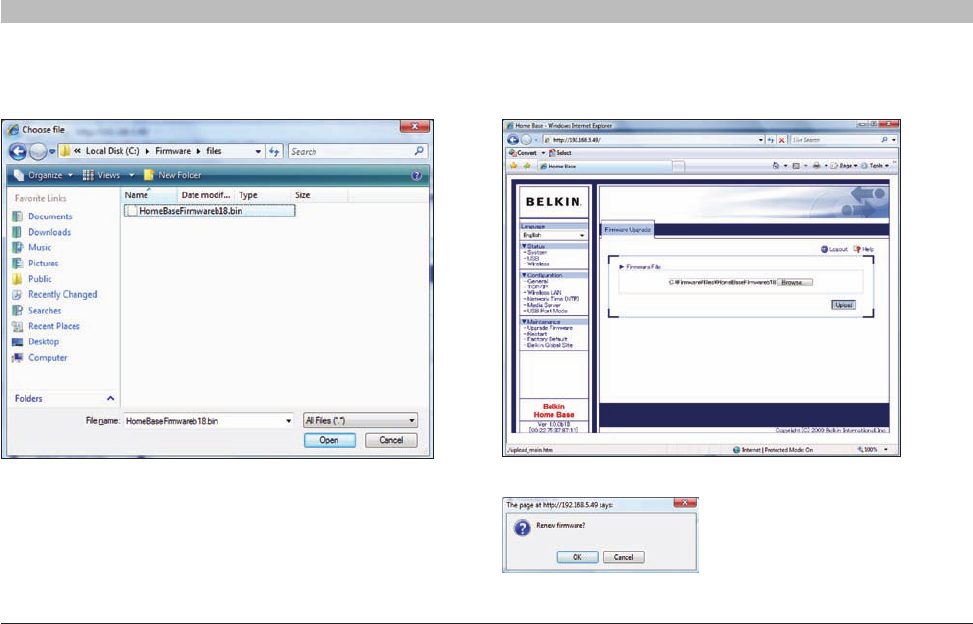
29
Home Base
SECTIONSTable of Contents 123456789 11 12 13 1410 13
UPGRADING HOME BASE FIRMWARE
Browse to the firmware file you downloaded from the Belkin website and
click “Open”.
Click “Upload”.
Click “OK” when the verification screen comes up.
Your firmware upgrade will take a few
minutes to complete after confirmation.
The firmware should now be upgraded.

30
Home Base
SECTIONSTable of Contents 123456789 1510 12 13 1411
TROUBLESHOOTING
General Troubleshooting
If you are having issues, be sure to try these general tips first:
Make sure the Home Base Control Center Software is the latest
version, and the Home Base Firmware is the latest version.
Software and Firmware updates are available on Belkin’s website at
http://www.belkin.com.
Control Center can’t find a Home Base
1. Is the product turned on? The AC adapter may be unplugged.
Check that the Power LED is lit.
2. Is the Link LED lit? If the Link LED is not turned on, it may not be
connected properly. Try rerunning the Home Base Setup Wizard
and configuring the wireless settings again (or try another network
cable if you are using a wired connection).
3. Make sure your computer’s wireless adapter and/or access point
is configured properly and note the configuration settings, paying
special attention to the wireless mode, SSID or network name, and
WEP/WPA/WPA2 security, so you can configure your Home Base
product to the same wireless settings.
4. Make sure you have a good wireless signal from the wireless
access point or router to your computer and to Home Base, that
Home Base is within range, and that it is away from metal objects
and devices that generate radio interference (like Bluetooth®
devices, cordless phones, and microwave ovens).
5. Is the network cable connected properly? The network (LAN)
cable may be unplugged or have bad contacts. Verify the cable
connections.
6. Is your computer on the network? If your computer is networked,
try to see if you can connect to other network computers or if
you can browse the Internet. Verify that the network is working
properly.
Disks not appearing in Windows Explorer or Mac OS X Finder,
other devices not appearing in Control Center
1. Is the USB cable connected properly? The USB cable may be
unplugged or have bad contacts. Verify the cable connections.
2. Is the USB disk-drive format supported? Home Base supports
FAT16-, FAT32-, and NTFS-formatted disk drives only. If you have
a disk you want to connect that has a different file format, you can
still connect to it in Network USB Mode, or you can reformat the
disk to FAT32 or NTFS and use it in Network Storage Mode.
Note: Refer to the FAQ page of this manual for more information.

31
Home Base
SECTIONSTable of Contents 123456789 1510 12 13 1411
TROUBLESHOOTING
11
Unable to select a disk for backup
1. The backup function of Home Base supports FAT16-, FAT32-, and
NTFS-formatted disk drives only.
Unreliable operation
1. Did you install any software just before your trouble occurred? The
software may be causing a problem. Remove the software you
installed and reinstall it.
2. Does the same problem occur after rebooting your PC? Rebooting
the PC may solve the problem.
Resetting Home Base to Factory Defaults
You can often resolve issues by resetting Home Base to factory-default
settings and running the setup software again. To reset Home Base to
factory defaults, unplug the power, and push and hold the reset button
down (you will need to use a paper clip or something small to hold it
down) on the bottom side of Home Base. Plug the power back into
Home Base while you are still holding down the reset button. When all of
the LEDs light up on Home Base (after about 4–5 seconds), let go of the
button. Home Base is reset to factory defaults.
Device Troubleshooting
If a device is visible in Control Center, but you cannot connect to it, your
firewall may be blocking the connection. During installation, Control
Center configures the Windows firewall to enable Home Base to operate
properly. But if you are running a third-party firewall, you may need to
specify settings to open a port and enable operation of the Home Base
and Control Center. For information on how to do this with several types
of popular firewalls, see the “Firewalls” section.
Printer Troubleshooting
When sharing a printer, the correct driver must be selected in the Device
Properties’ “Connections” tab. For more information, see the “Printer
Connection Properties” section.
VPN Troubleshooting
Home Base may not work with VPN (Virtual Private Network) as VPN
filters the connection between the computer and other network devices.
If you have VPN enabled and Home Base does not work, please turn off
the VPN connection.

32
Home Base
SECTIONSTable of Contents 123456789 1510 13 141211
FIREWALLS
This topic shows you how to create an exception for Control Center in several popular firewall programs. Because firewalls are
designed to block unwanted intrusions into your network, you must specify settings that tell the firewall that Control Center should
be allowed to communicate with the Home Base on your network.
The instructions are for the versions of the firewall programs that appear below. If you have a different version of a given firewall, the
locations of some options may differ from those provided here.
• WindowsLive™OneCare™
• McAfee® Security Center 2007
• Norton™InternetSecurity2007
• TrendMicro® PC-cillin Internet Security 2007
• ZoneAlarm®
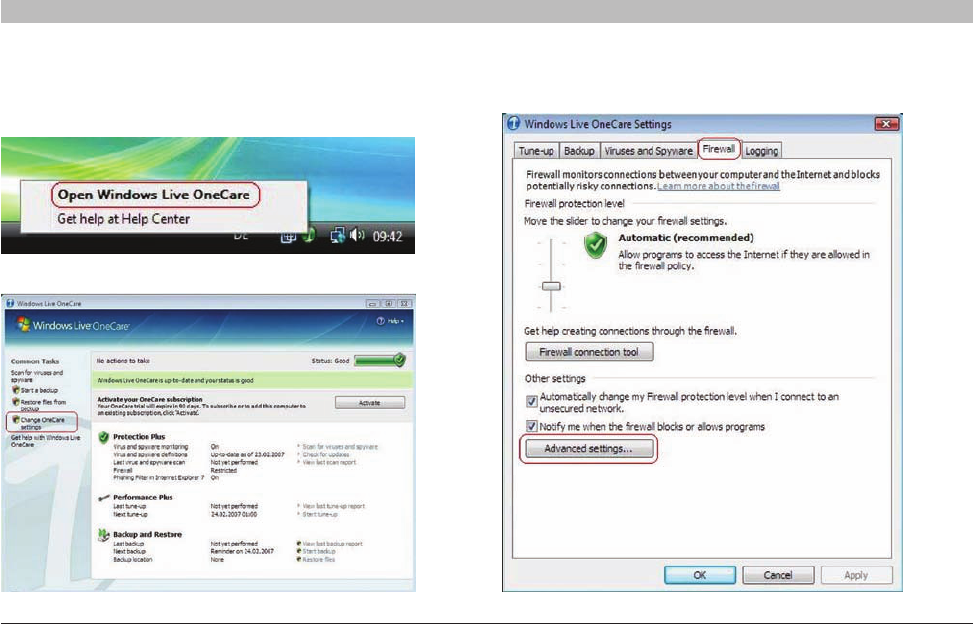
33
Home Base
SECTIONSTable of Contents 123456789 1510 13 141211
FIREWALLS
2. Click “Change OneCare settings”.
Windows Live OneCare
1. Right-click on the Windows Live OneCare icon in the task bar.
3. Select “Firewall” and click “Advanced settings”.
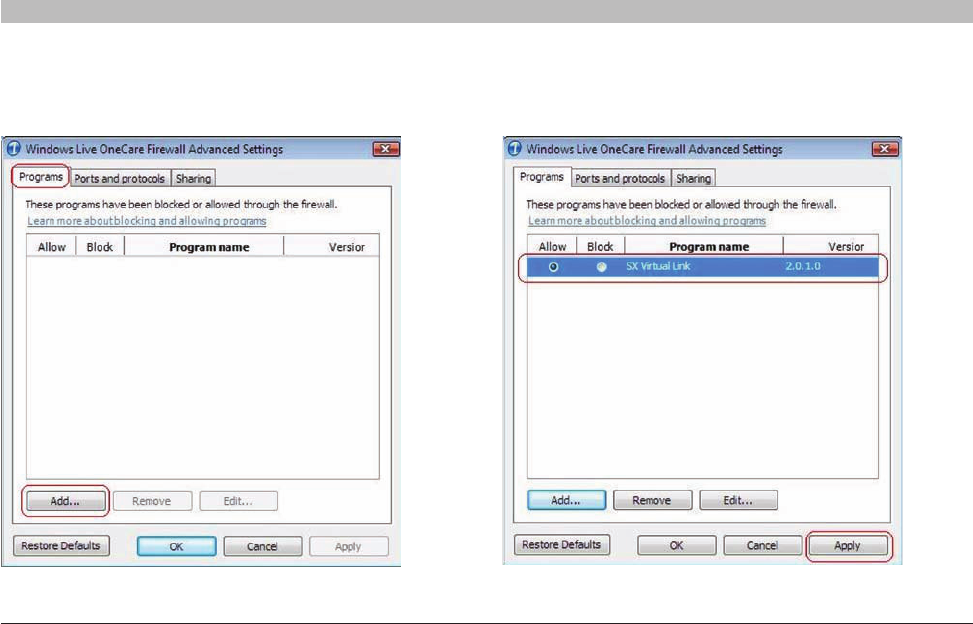
34
Home Base
SECTIONSTable of Contents 123456789 1510 13 141211
FIREWALLS
4. Select “Programs” and click “Add”. 5. Select “connect.exe” from the folder where Control Center is
installed. The default path is: C:\Program Files\BELKIN\Home Base
Control Center\Connect.exe.
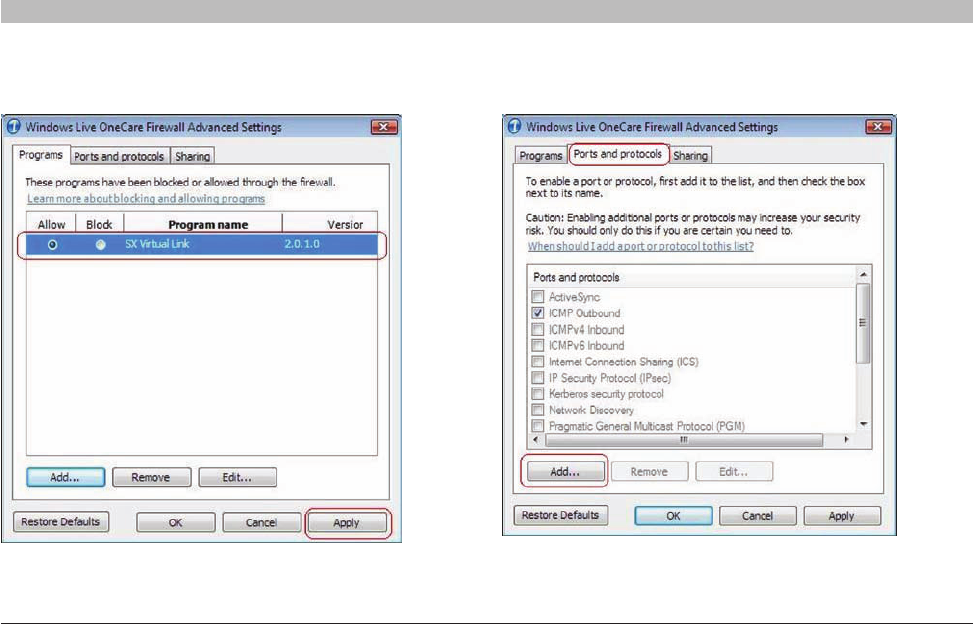
35
Home Base
SECTIONSTable of Contents 123456789 1510 13 141211
FIREWALLS
6. Check that the software is set to “Allow”. Click “Apply”. 7. Now go to “Ports and protocols” and click “Add”.
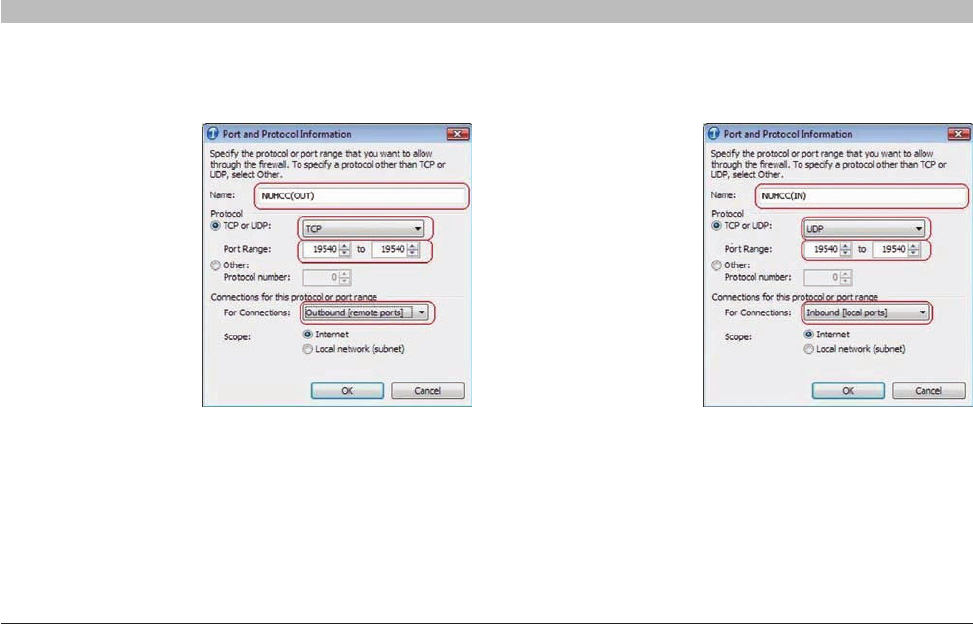
36
Home Base
SECTIONSTable of Contents 123456789 1510 13 141211
FIREWALLS
8. Add a new exception, one for outgoing data.
Name
Home Base (Out)
TCP or UDP
TCP
Port Range
19540 to 19540
For Connections
Outbound [remote ports]
Scope
Internet
9. Add another new exception, one for incoming data.
Name
Home Base (In)
TCP or UDP
UDP
Port Range
19540 to 19540
For Connections
Inbound [local ports]
Scope
Internet
10. Check the new exceptions you just created. Make sure that both
exceptions are enabled.
11. Finish the configuration. You must reboot your computer for the
changes to take effect.
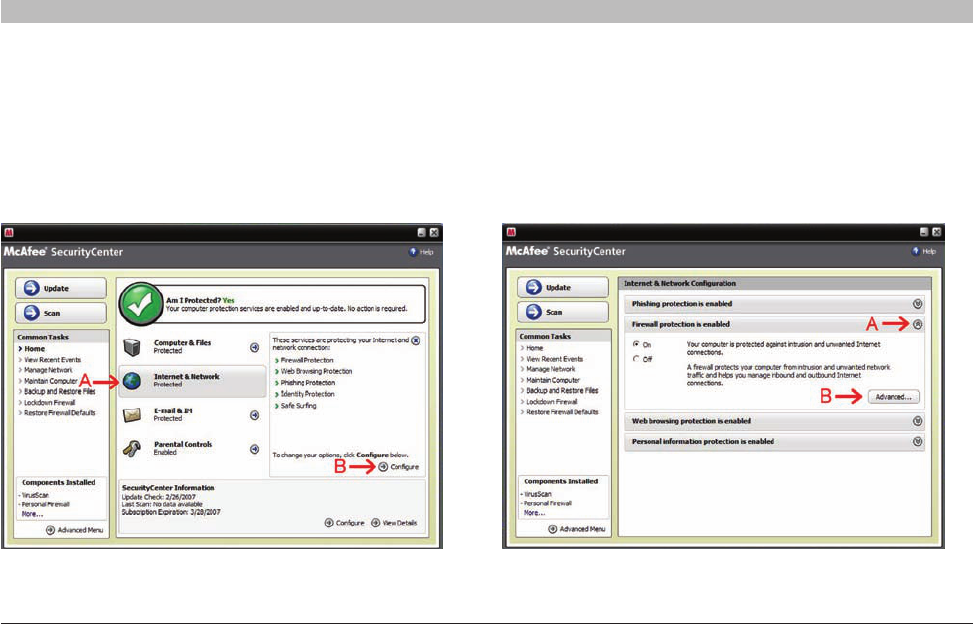
37
Home Base
SECTIONSTable of Contents 123456789 1510 13 141211
FIREWALLS
McAfee Security Center 2007
1. Click “Start > All Programs > McAfee”. Select “McAfee
Security Center”.
2. Select “Internet & Network” (A) and then click on the option to
“Configure” (B).
3. Expand the “Firewall Protection is enabled” list by clicking on the
arrows (A). Then click “Advanced” (B).

38
Home Base
SECTIONSTable of Contents 123456789 1510 13 141211
FIREWALLS
4. Ensure that “Program Permissions” on the left is highlighted (A).
Click “Add Allowed Program” (B).
5. Browse to the folder where Control Center is installed.
The default path is C:\Program Files\BELKIN\Home Base Control
Center\Connect.exe. Select the program (highlighted below) and
click “Open”.
6. Click “OK”. You may need to reboot your computer for the new
settings to take effect.
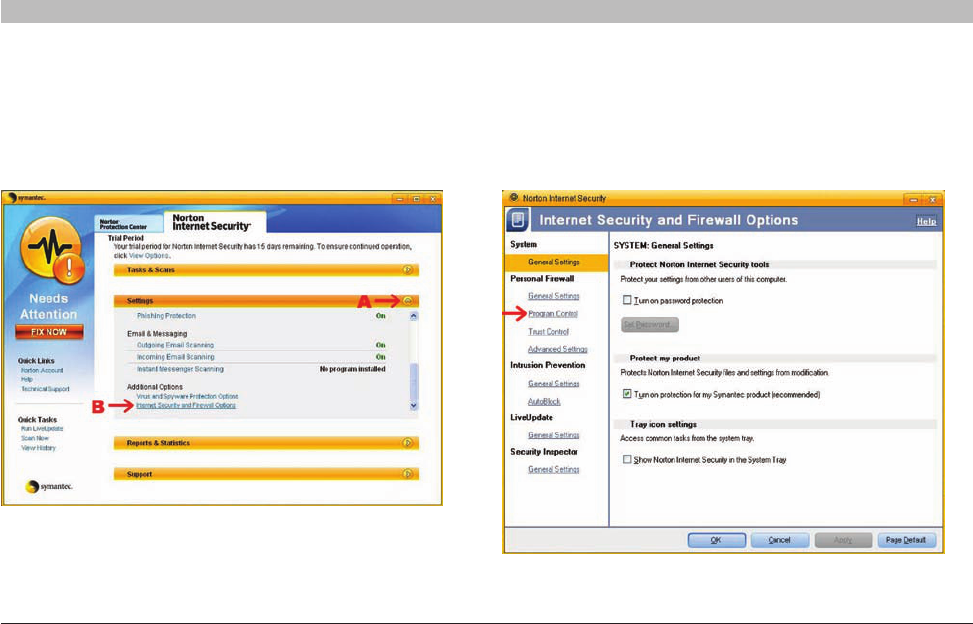
39
Home Base
SECTIONSTable of Contents 123456789 1510 13 141211
FIREWALLS
Norton Internet Security 2007
1. Go to “Start > All Programs > Norton Internet Security”. Select
“Norton Internet Security”. Expand “Settings” (A), scroll down to
“Internet Security and Firewall Options” (B) and click it.
2. Select “Program Control”.
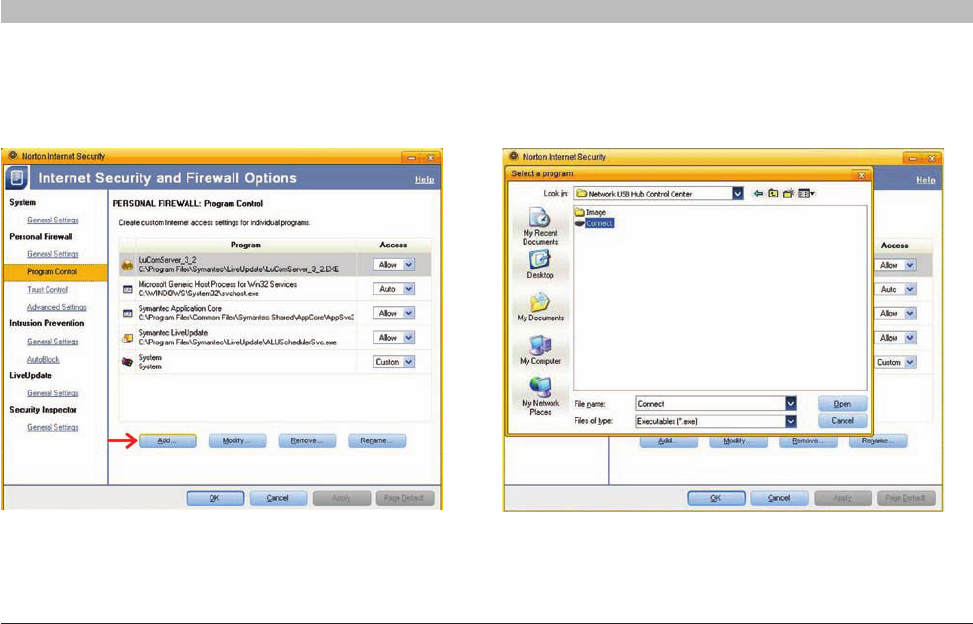
40
Home Base
SECTIONSTable of Contents 123456789 1510 13 141211
FIREWALLS
3. Click “Add”. 4. Browse to the folder where Control Center is installed.
The default path is C:\Program Files\BELKIN\Home Base Control
Center\Connect.exe. Select the program (highlighted below) and
click “Open”.

41
Home Base
SECTIONSTable of Contents 123456789 1510 13 141211
FIREWALLS
5. Program control will then ask you for the appropriate action for this
program. Choose “Allow” and click “OK”.
6. Click “Apply”. This confirms and applies the exception for Control
Center. Click “OK” to exit. You may need to reboot your computer
for the changes to take effect.

42
Home Base
SECTIONSTable of Contents 123456789 1510 13 141211
FIREWALLS
Trend Micro PC-cillin Internet Security 2007
1. Go to “Start > All Programs > Trend Micro PC-cillin Internet
Security 2007”. Select “Trend Micro PC-cillin Internet
Security 2007”.
2. Click “Personal Network & Firewall Controls” on the left.
3. Click “Settings”.
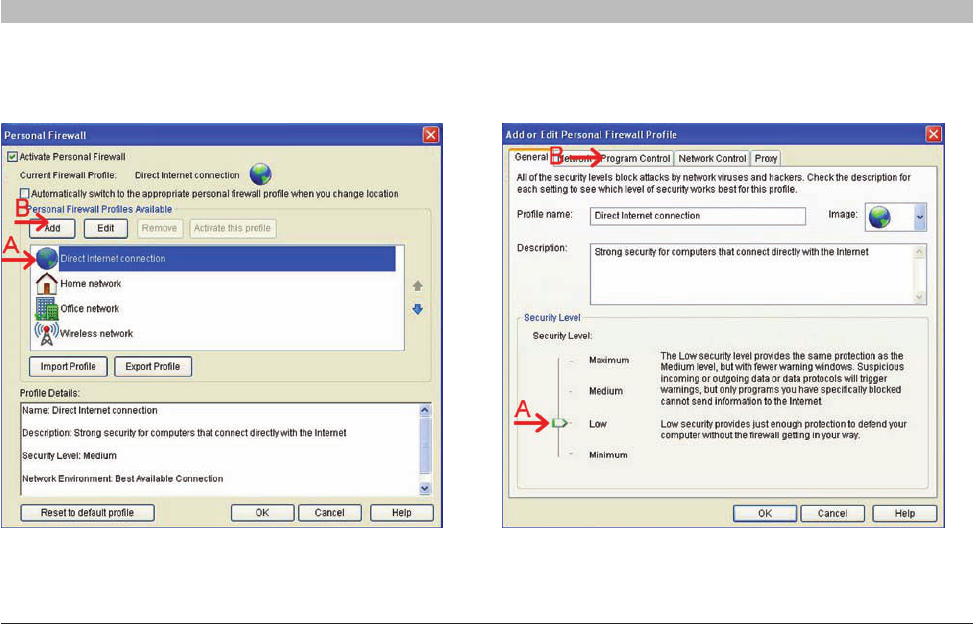
43
Home Base
SECTIONSTable of Contents 123456789 1510 13 141211
FIREWALLS
4. Ensure that the option “Direct Internet connection” is highlighted
(A), and then click “Add” (B).
5. On the next screen ensure that the security level is set to “Low” (A).
Click the “Program Control” tab (B).

44
Home Base
SECTIONSTable of Contents 123456789 1510 13 141211
FIREWALLS
6. Click “Add”. 7. Browse to the folder where Control Center is installed.
The default path is C:\Program Files\BELKIN\Home Base Control
Center\Connect.exe.
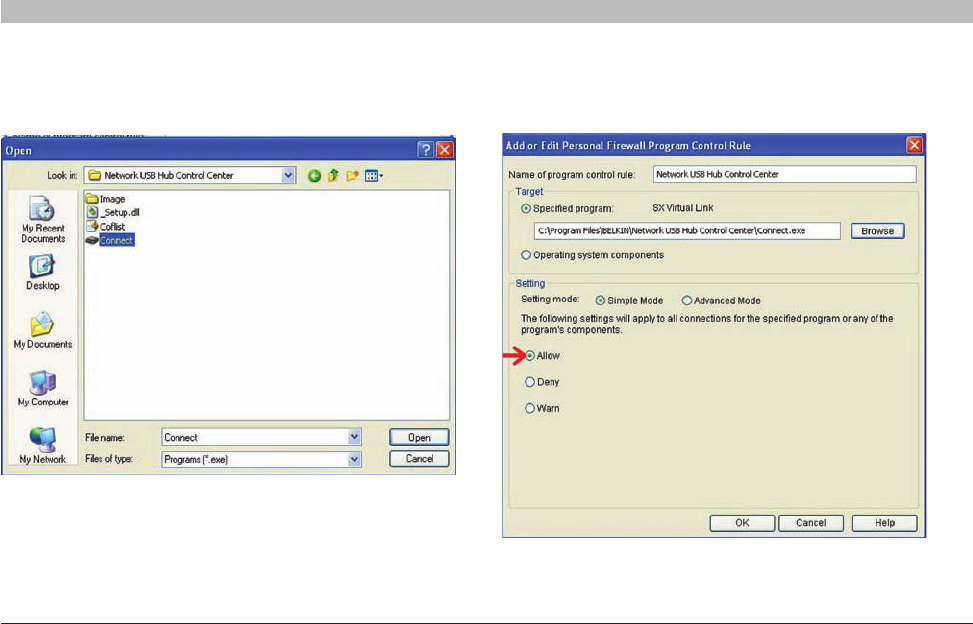
45
Home Base
SECTIONSTable of Contents 123456789 1510 13 141211
FIREWALLS
8. Ensure that the program setting is set on “Simple Mode”
and that the “Allow” option is selected. Click “OK”, and
then “OK” once more.
Select the program “Connect” and click “Open”.
You may need to reboot your computer for the changes to take effect.
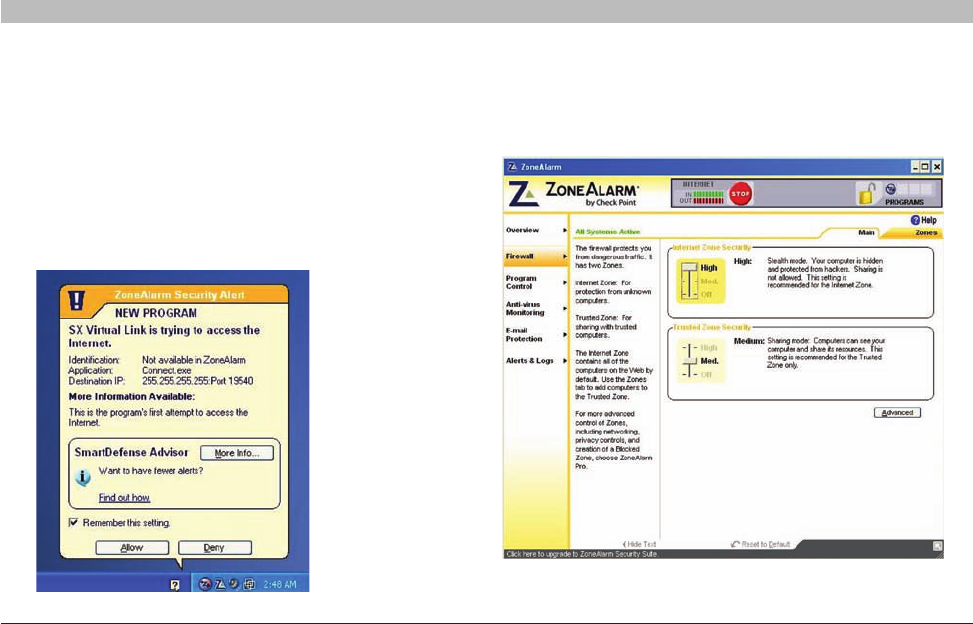
46
Home Base
SECTIONSTable of Contents 123456789 1510 13 141211
FIREWALLS
ZoneAlarm
1. In Control Center, click “Configure General Hub Settings” under
“Tasks” in Control Center. The “Home Base Settings Properties”
tabs appear. Select the “Connected Home Bases” tab.
2. Write down the IP address of your Home Base.
3. Right-clickontheZoneAlarmiconinthetaskbarandopenthe
ZoneAlarmControlCenter.
4. Select“Firewall”.Select“Zones”andclick“Add”.

47
Home Base
SECTIONSTable of Contents 123456789 1510 13 141211
FIREWALLS
5. Select “IP Address”.
6. Enter the IP address that you wrote down earlier. Click “OK”.
7. Verify your settings.
8. Make sure that the IP address of Home Base is listed in the
“Trusted” zone and click “Firewall”. The connection in Control
Center should now be enabled.

48
Home Base
SECTIONSTable of Contents 123456789 1510 14131211
FAQS
Control Center and USB devices
(“Available Devices” tab)
Q: I can see a USB device in Control Center, but I can’t connect to
it. What should I do?
A: Check your firewall settings. During installation, the Control
Center configures the Windows firewall to enable connection,
but third-party firewalls may require additional settings. For more
information about how to configure several specific firewalls, see
the “Firewalls” section.
Q: Does this product work with any-speed USB device?
A: Yes. The Home Base supports Hi-, full-, and low-speed devices.
Information about the type of speed supported by a device is
gathered by Control Center from the device and displayed in the
Device Properties’ “General” tab.
Q: Why does the Windows AutoPlay screen appear every time I
connect to a device?
A: By default, Windows automatically plays many types of USB
devices. You can turn off this feature in Windows XP by clicking
“Start” and “Run”. In the “Run” field, type in “gpedit.msc” (without
the quotes). On the “Group Policy” screen, select “Computer
Configuration > Administrative Templates”. Click “System”. Double-
click “Turn off Autoplay”. On the “Setting” tab, select “Disabled”
and click “OK”.
Q: Why would I want to automatically start a specific piece of
software when I connect to a device?
A: Many USB items use specific software to carry out their functions.
For example, a webcam will need software to capture video. The
Belkin Control Center enables you to specify that the software
automatically start when a device is connected to the Home Base.
For more information, see Device Properties’ “Connection” tab.
Q: Do I have to shut down Control Center completely before
installing an update? Do I need to reboot my computer
after installing?
A: No, you can install updates while Control Center is running and
devices are connected. You do not need to reboot your computer
after installing an update.
USB disk drives and other storage devices
Q: What is a NAS (Network Attached Storage)?
A: A NAS device is a server specifically designed for handling files.
Network Attached Storage is accessible directly on the local area
network (LAN) from multiple users.
Q: What file systems can be used with Home Base in NAS mode?
A: Home Base will automatically mount FAT12, FAT16, FAT32, and
NTFS volumes in NAS mode. Disks using other file systems will be
available to one user at a time in Network USB mode.

49
Home Base
SECTIONSTable of Contents 123456789 1510 14131211
FAQS
Q: How do I access USB disk drives connected to Home Base?
A: In Windows, Control Center automatically maps a new drive letter
for your computer for each supported USB disk drive connected to
Home Base. You can access the drive by going to “Computer” (or
“My Computer” if you are using Windows XP or 2000).
You can go to Windows Internet Explorer and type
“\\BK-HBxxxxxx” (where “xxxxxx” is the last six digits of Home
Base’s MAC address, printed on the bottom of Home Base)
into the address bar. Alternatively, you can browse the Windows
network and look for “\\BK-HBxxxxxx” in the list of available
network devices.
For Macintosh® computers, Control Center automatically mounts
discs connected to Home Base to the desktop. Alternatively, click
“Go > Connect to server” to connect to the disk.
Q: How are drive letters mapped on Windows?
A: When Control Center is running, disk volumes will be mapped to
drivelettersstartingwithZtoavoidcollisionwithcommonlyused
drive letters.
Q: What is the difference between Network USB mode and
NAS mode?
A: In Network USB mode, it is as if the USB device is connected
directly to your computer by a USB cable. If one person is using
a device, no one else will be able to connect to it. Many different
kinds of devices can be used. In NAS mode, a USB device can
be accessed from multiple computers at the same time; this only
works with USB storage devices and file sharing.
Q: Are there any limitations to how much data can be shared?
A: No, the amount of data that can be shared depends on the size
of the connected disk.
Q: Can files be shared between Windows and Mac OS?
A: Yes, files can be shared between Windows and Mac
OS X computers.
Q: Can filters be applied to prevent certain people from
accessing files?
A: Files are made public to all computers on the network.

50
Home Base
SECTIONSTable of Contents 123456789 1510 14131211
FAQS
Q: Can a password be set for a file?
A: Passwords cannot be set. If security is necessary, use
file-compression software to create a password-protected archive.
Q: Can files be encrypted when used with the Home Base
NAS feature?
A: No, files are all saved as they are. This applies to disks formatted
as NTFS, too.
Q: Can compressed disk drives be used?
A: No, compressed drives cannot be shared via Home Base’s
NAS feature.
Q: What protocol is used for sharing?
A: The Windows file-sharing protocol is used. It is commonly referred
to as SMB or CIFS.
Q: What is the password to log in to the FTP server?
A: The user ID is root, and the password is the password you
configured on the web page, if any. By default, there is no
password. In this case, log in by pressing the “Enter” key without
entering a password.
Q: Is it safe to unplug a connected USB device at any time?
A: The device you are unplugging may be in use by another PC
or accessed by picture sharing, etc. Data may be destroyed if
unplugged suddenly. Always follow the “Safe Removal” procedure
to remove devices.
Q: Can I log in to a network domain environment using the
NAS mode?
A: A domain environment cannot be logged in to.
Q: When multiple USB disk drives are connected, can they be set
up to use RAID?
A: A RAID cannot be established using multiple disks attached to
Home Base, but Home Base can access a USB RAID device as a
single disk.

51
Home Base
SECTIONSTable of Contents 123456789 1510 11 12 13 14
TECHNICAL SUPPORT
You can find technical support information at http://www.belkin.com/networking or www.belkin.com through the tech support
area. If you want to contact technical support by phone, please call:
Belkin Tech Support
US: 877-736-5771
800-223-5546 ext.2263
310-898-1100 ext.2263
UK: 0845 607 77 87
Australia: 1800 235 546
NewZealand:0800235546
Singapore: 65 64857620
Europe: www.belkin.com/support
Belkin International, Inc.
501 West Walnut Street
Los Angeles, CA 90220, USA
310 -898 -1100
310-898-1111 fax
Belkin Ltd.
Express Business Park, Shipton Way
Rushden, NN10 6GL, United Kingdom
+44 (0) 1933 35 2000
+44 (0) 1933 31 2000 fax
Belkin B.V.
Boeing Avenue 333
1119 PH Schiphol-Rijk, The Netherlands
+31 (0) 20 654 7300
+31 (0) 20 654 7349 fax
Belkin Ltd.
4 Pioneer Avenue
Tuggerah Business Park
Tuggerah, NSW 2259, Australia
+61 (0) 2 4350 4600
+61 (0) 2 4350 4700 fax

52
Home Base
SECTIONSTable of Contents 12345678910 11 12 13 14 15
INFORMATION
Federal Communications Commission Notice
This equipment has been tested and found to comply with the limits for a Class
B digital device, pursuant to Part 15 of the FCC Rules. These limits are designed
to provide reasonable protection against harmful interference in a residential
installation.
This equipment generates, uses, and can radiate radio frequency energy, and if
not installed and used in accordance with the instructions, may cause harmful
interference to radio communications. However, there is no guarantee that
interference will not occur in a particular installation. If this equipment does cause
harmful interference to radio or television reception, which can be determined by
turning the equipment off and on, the user is encouraged to try and correct the
interference by one or more of the following measures:
• Reorientorrelocatethereceivingantenna.
• Increasethedistancebetweentheequipmentandthereceiver.
• Connecttheequipmenttoanoutletonacircuitdifferentfromthattowhichthe
receiver is connected.
• Consultthedealeroranexperiencedradio/TVtechnicianforhelp.
For IEEE 802.11b/g/n products in the USA market, only channels 1 through 11 can
be operated. Selection of other channels is not possible.
This device and its antenna(s) must not be co-located or operating in conjunction
with any other antenna or transmitter.
FCC Statement
DECLARATION OF CONFORMITY WITH FCC RULES FOR
ELECTROMAGNETIC COMPATIBILITY
We, Belkin International, Inc., of 501 West Walnut Street, Compton, CA 90220,
declare under our sole responsibility that the device,
F5L049
complies with Part 15 of the FCC Rules. Operation is subject to the following two
conditions: (1) this device may not cause harmful interference, and (2) this device
must accept any interference received, including interference that may cause
undesired operation.
Caution:ExposuretoRadioFrequencyRadiation.
The device shall be used in such a manner that the potential for human contact
normal operation is minimized.
This equipment complies with FCC radiation exposure limits set forth for an
uncontrolled environment. This equipment should be installed and operated with a
minimum distance of 20cm between the radiator and your body.

53
Home Base
SECTIONSTable of Contents 12345678910 11 12 13 14 15
INFORMATION
Europe – EU Declaration of Conformity
This device complies with the essential requirements of the R&TTE Directive 1999/5/
EC.The following test methods have been applied in order to prove presumption of
conformity with the essential requirements of the R&TTE Directive 1999/5/EC:
EN60950-1: 2006: Safety of Information Technology Equipment
EN50385: 2002-08: Product standard to demonstrate the compliance of radio base
stations and fixed terminal stations for wireless telecommunication systems with
the basic restrictions or the reference levels related to human exposure to radio
frequency electromagnetic fields (110MHz–40GHz) - General public
EN 300 328 V1.7.1: 2006-10: Electromagnetic compatibility and radio spectrum
matters (ERM); wideband transmission systems; data transmission equipment
operating in the 2.4GHz ISM band and using spread spectrum modulation
techniques; harmonized EN covering essential requirements under article 3.2 of the
R&TTE Directive
EN 301 489-1 V1.8.1: 2008: Electromagnetic compatibility and radio spectrum
matters (ERM); electromagnetic compatibility (EMC) standard for radio equipment
and services; Part 1: Common technical requirements
EN 301 489-17 V1.3.2: 2008: Electromagnetic compatibility and radio spectrum
matters (ERM); electromagnetic compatibility (EMC) standard for radio equipment
and services; Part 17: Specific conditions for 2.4GHz wideband transmission
systems and 5GHz high-performance RLAN equipment
This device is a 2.4GHz wideband transmission system (transceiver), intended for
use in all EU member states and EFTA countries, except in France and Italy where
restrictive use applies.
In Italy the end user should apply for a license at the national spectrum authorities
in order to obtain authorization to use the device for setting up outdoor radio links
and/or for supplying public access to telecommunications and/or network services.
This device may not be used for setting up outdoor radio links in France and, in
some areas, the RF output power may be limited to 10mW EIRP in the frequency
range of 2454–2483.5MHz. For detailed information, the end user should contact
the national spectrum authority in France.
Modifications
The FCC requires the user to be notified that any changes or modifications to this
device that are not expressly approved by Belkin International, Inc., may void the
user’s authority to operate the equipment.
Industry Canada Statement
This device complies with RSS-210 of the Industry Canada Rules. Operation is
subject to the following two conditions:
This device may not cause harmful interference, and (2) this device must accept any
interference received, including interference that may cause undesired operation.
IMPORTANTNOTE:RadiationExposureStatement
This equipment complies with IC radiation exposure limits set forth for an
uncontrolled environment. This equipment should be installed and operated with
a minimum distance of 20cm between the radiator and your body. This device has
been designed to operate with an antenna having a maximum gain of 2 dB. An
antenna with a higher gain is strictly prohibited per regulations of Industry Canada.
The required antenna impedance is 50 Ohms.
This Class B digital apparatus complies with Canadian ICES-003.
Cet appareil numérique de la classe B conforme á la norme NMB-003 du Canada.
For product available in the USA/Canada market, only channel 1~11 can be
operated. Selection of other channels is not possible.
This device and its antenna(s) must not be co-located or operating in conjunction
with any other antenna or transmitter.
To reduce potential radio interference to other users, the antenna type and its gain
should be so chosen that the equivalent isotropically radiated power (EIRP) is not
more than that permitted for successful communication.

54
Home Base
SECTIONSTable of Contents 12345678910 11 12 13 14 15
INFORMATION
Belkin International, Inc., Limited 1-Year Product Warranty
What is not covered by this warranty?
All above warranties are null and void if the Belkin product is not
provided to Belkin for inspection upon Belkin’s request at the sole
expense of the purchaser, or if Belkin determines that the Belkin product
has been improperly installed, altered in any way, or tampered with.
The Belkin Product Warranty does not protect against acts of God such
as flood, lightning, earthquake, war, vandalism, theft, normal-use wear
and tear, erosion, depletion, obsolescence, abuse, damage due to low
voltage disturbances (i.e. brownouts or sags), non-authorized program,
or system equipment modification or alteration.
How to get service.
To get service for your Belkin product you must take the following steps:
1. Contact Belkin International, Inc., at 501 W. Walnut St.,
Compton, CA 90220, Attn: Customer Service, or call (800)-223-5546,
within 15 days of the Occurrence. Be prepared to provide the
following information:
a. The part number of the Belkin product.
b. Where you purchased the product.
c. When you purchased the product.
d. Copy of original receipt.
2. Your Belkin Customer Service Representative will then instruct you
on how to forward your receipt and Belkin product and how to
proceed with your claim.
What this warranty covers.
Belkin International, Inc. (“Belkin”) warrants to the original purchaser of
this Belkin product that the product shall be free of defects in design,
assembly, material, or workmanship.
What the period of coverage is.
Belkin warrants the Belkin product for one year.
What will we do to correct problems?
Product Warranty.
Belkin will repair or replace, at its option, any defective product free of
charge (except for shipping charges for the product). Belkin reserves the
right to discontinue any of its products without notice, and disclaims any
limited warranty to repair or replace any such discontinued products.
In the event that Belkin is unable to repair or replace the product (for
example, because it has been discontinued), Belkin will offer either a
refund or a credit toward the purchase of another product from Belkin.
com in an amount equal to the purchase price of the product as
evidenced on the original purchase receipt as discounted by its
natural use.

55
Home Base
SECTIONSTable of Contents 12345678910 11 12 13 14 15
INFORMATION
Belkin reserves the right to review the damaged Belkin product. All
costs of shipping the Belkin product to Belkin for inspection shall be
borne solely by the purchaser. If Belkin determines, in its sole discretion,
that it is impractical to ship the damaged equipment to Belkin, Belkin
may designate, in its sole discretion, an equipment repair facility to
inspect and estimate the cost to repair such equipment. The cost, if any,
of shipping the equipment to and from such repair facility and of such
estimate shall be borne solely by the purchaser. Damaged equipment
must remain available for inspection until the claim is finalized.
Whenever claims are settled, Belkin reserves the right to be subrogated
under any existing insurance policies the purchaser may have.
How state law relates to the warranty.
THIS WARRANTY CONTAINS THE SOLE WARRANTY OF BELKIN.
THERE ARE NO OTHER WARRANTIES, EXPRESSED OR, EXCEPT AS
REQUIRED BY LAW, IMPLIED, INCLUDING THE IMPLIED WARRANTY
OR CONDITION OF QUALITY, MERCHANTABILITY OR FITNESS FOR A
PARTICULAR PURPOSE, AND SUCH IMPLIED WARRANTIES, IF ANY,
ARE LIMITED IN DURATION TO THE TERM OF THIS WARRANTY.
Some states do not allow limitations on how long an implied warranty
lasts, so the above limitations may not apply to you.
IN NO EVENT SHALL BELKIN BE LIABLE FOR INCIDENTAL, SPECIAL,
DIRECT, INDIRECT, CONSEQUENTIAL OR MULTIPLE DAMAGES SUCH
AS, BUT NOT LIMITED TO, LOST BUSINESS OR PROFITS ARISING
OUT OF THE SALE OR USE OF ANY BELKIN PRODUCT, EVEN IF
ADVISED OF THE POSSIBILITY OF SUCH DAMAGES.
This warranty gives you specific legal rights, and you may also have
other rights, which may vary from state to state. Some states do not
allow the exclusion or limitation of incidental, consequential, or other
damages, so the above limitations may not apply to you.

Belkin International, Inc.
501 West Walnut Street
Los Angeles, CA 90220, USA
310-898-1100
310- 8 9 8 -1111 fa x
Belkin Ltd.
Express Business Park, Shipton Way
Rushden, NN10 6GL
United Kingdom
+44 (0) 1933 35 2000
+44 (0) 1933 31 2000 fax
© 2009 Belkin International, Inc. All rights reserved. All trade names are registered trademarks of respective
manufacturers listed. Mac OS and Macintosh are trademarks of Apple Inc., registered in the U.S. and other
countries. Windows, Windows Live, OneCare, Internet Explorer, and Windows Vista are either registered
trademarks or trademarks of Microsoft Corporation in the United States and/or other countries.
Belkin B.V.
Boeing Avenue 333
1119 PH Schiphol-Rijk, The Netherlands
+31 (0) 20 654 7300
+31 (0) 20 654 7349 fax
Belkin Ltd.
4 Pioneer Avenue
Tuggerah Business Park
Tuggerah, NSW 2259, Australia
+61 (0) 2 4350 4600
+61 (0) 2 4350 4700 fax
Belkin Tech Support
US: 877-736-5771
800-223-5546 ext.2263
310-898-1100 ext.2263
UK: 0845 607 77 87
Australia: 1800 235 546
NewZealand:0800235546
Singapore: 65 64857620
Europe: www.belkin.com/support